Reserve Bank Bulletin – November 1999 Semi-Annual Statement on Monetary Policy
Download the complete Statement 535KB
International economic conditions have improved further in recent months. The United States economy has continued its exceptionally strong growth performance, while the recoveries which began in the crisis countries in east Asia last year have persisted, and in most cases strengthened. Prospects for the region will be assisted, moreover, by the expansion which now seems to be under way in Japan. The initial stages of the Japanese recovery were heavily dependent on public sector spending, but evidence is now emerging that private demand has begun to grow. In Europe, the degree of strength varies among the major economies, but all appear to be experiencing an upturn in growth. Recovery is also taking place, at varying rates, in Latin America.
As a result of these trends, which generally have been stronger than expected, estimates of global growth in 1999 have been revised up further since the Bank's August report. Prospects for next year are for better growth again, even taking account of the expected slowing in the pace of the US expansion. As of late 1999, the outlook for the world economy appears brighter than at any time since the Asian crisis broke in mid 1997, a distinct contrast to the situation a year ago.
This change has led to an increase in both short-term and long-term interest rates in most industrialised countries, as markets questioned the continuation of the accommodative monetary stance central banks have generally been following over the past year or two. The upward pressure in interest rates began in the US, the country most advanced in its economic cycle, but quickly spread to other English-speaking countries and, more recently, to Europe. Japan remains the exception to this pattern. Against a background of rising interest rates, share markets in most countries have been subdued, with share price indices down by 5–10 per cent from their recent peaks, and showing increased volatility.
The Australian economy has continued to record very good growth throughout the period of the Asian crisis and the ensuing global growth decline, despite export losses. A robust expansion in domestic demand has persisted, mainly reflecting the strength of household consumption spending. Some temporary factors, such as the receipt of proceeds of demutualisations and capital gains from privatisations, have contributed to that strength. But more general support for consumer spending is coming from growing incomes, sustained high levels of confidence, low borrowing costs and wealth gains across a range of assets. In addition, the housing sector seems to be gathering pace, after a flat period through 1998. Some further decline in construction spending by businesses is likely, but on present indications other areas of investment spending could grow through the next twelve months.
The improved external environment, together with ongoing strength in domestic demand, means that Australia's growth prospects have also improved. The prospective reduction in the Commonwealth's fiscal surplus in 2000/01 is also a factor that will, at the margin, support growth. For these reasons, it is now unlikely that a decline in overall growth, if it occurred, would be pronounced or long-lasting. The Bank expects that the economy will experience quite good growth over the next couple of years.
Inflation has remained well under control. It is, however, gradually moving higher, even though growth in labour costs has remained quite subdued, and is now running at rates consistent with the lower end of the target zone. The increase in the CPI over the latest year, at 1.7 per cent, has been held down by the effects of the health insurance rebate introduced in early 1999, which will cease to affect the measured inflation rate early in 2000. Abstracting from this factor, the rise in the CPI over the latest twelve months was just over 2 per cent. The rise in the price of oil which occurred during 1999 is pushing up the CPI, and changes in indirect tax rates during the second half of 1999 will affect the statistics during the December quarter. Various measures of core or underlying inflation, which are less affected by these temporary factors, are also gradually increasing, and over the year to September were around 2 per cent.
By mid 2000, the Bank expects annual CPI inflation to be a little higher again, running at around 2¾ per cent. In the September quarter next year, the net effect of the implementation of the GST and the abolition of wholesale sales taxes will result in a one-time rise in the price level, and a temporary rise in the measured rate of CPI inflation, with the short-term effect likely to be larger than the long-run effect. By September 2001, when the short-term GST effect will have dropped out of the annual calculation, the Bank currently expects that CPI inflation should once again be between 2 and 3 per cent. This is based on the assumption that there will be no second-round GST impacts, via compensatory wage agreements or opportunistic pricing decisions. The Bank will be abstracting from the impact effect of the GST for the purpose of assessing the trend in inflation. It is important that those involved in wage decisions do likewise.
It is apparent that the stance of monetary policy in place through the past couple of years has assisted the economy through the period when the contractionary forces have been at their most intense. That this stance has been expansionary is clear not only from the levels of nominal and real interest rates, which for borrowers have been below the lows reached in the early 1990s, but also in the pace of credit growth, the run-up in household debt, and the appreciation in some asset prices. Other policy outcomes have been important, and some one-off factors also operated in the expansionary direction, but the lengthy period of low interest rates has been a major factor supporting growth. This stance of policy has also accommodated a gradual return of inflation to the target.
The economy is now, however, in a new phase. Over the past couple of years, the prevailing concern was to limit the risk of an abrupt decline in growth, and to facilitate a return of inflation to the target. Growth now seems secure, and the risk of a sharp slowdown has fallen considerably. The disinflationary forces seen over the past couple of years, both globally and domestically, are waning, suggesting that a fall in inflation back below the target is now unlikely. It was on the basis of this assessment of the outlook, the stance of policy and the change in the balance of risks, that the Bank recently decided in favour of a modest increase in interest rates, in order to move monetary policy to a less accommodating position. This was anticipated by financial markets, which had moved to price in a tightening, based on worldwide trends and the improving growth outlook in Australia.
The Bank's intention in making this adjustment is not to end growth, but to keep the setting of monetary policy attuned to the economy's changing needs. This will assist in further lengthening the current economic expansion, which is already the longest since the 1960s. A long expansion offers the best prospect for achieving a sustained further reduction in unemployment.
International Economic Developments
There has been a noticeable improvement in world economic conditions over the past six months. After slowing to 2½ per cent in 1998, world output growth is now forecast by the IMF to pick up to 3 per cent this year (Table 1). Such an improvement in world growth is a substantially better outcome than was expected six months ago. At that stage, world growth was expected to decline. The upward revision reflects not only the continuation of robust growth in the US, but also stronger than expected recoveries in Japan and Asia more generally. World growth is forecast to strengthen further in 2000 to 3½ per cent – the average growth rate in the world economy over the past 30 years. This pick-up reflects a continued improvement in growth in Japan and Europe, and the consolidation of the recoveries across Asia. It also incorporates GDP growth in the US easing back, although there are few signs of that happening at present.
| 1997 | 1998 | 1999(f) May 1999 |
1999(f) October 1999 |
2000(f) October 1999 |
|
|---|---|---|---|---|---|
| United States | 3.9 | 3.9 | 3.3 | 3.7 | 2.6 |
| Euro area | 2.4 | 2.8 | 2.0 | 2.1 | 2.8 |
| Japan | 1.4 | −2.8 | −1.4 | 1.0 | 1.5 |
| NIEs | 5.8 | −1.8 | 2.1 | 5.2 | 5.1 |
| ASEAN-4 | 3.6 | −9.8 | −1.1 | 1.4 | 3.6 |
| World | 4.2 | 2.5 | 2.3 | 3.0 | 3.5 |
|
(a) Using PPP exchange rates Source: IMF World Economic Outlook, May and October 1999 |
|||||
Inflation remains quite low globally, although the turnaround in growth prospects suggests that the disinflationary forces that have been noticeable over the past two years are now gradually abating. A range of commodity prices have risen, as a result of both a firming in demand conditions and a curtailment of supply. Of these, the increase in oil prices is the most prominent. Since the March agreement between major oil producers to cut production, oil prices have risen sharply; in October the crude oil price averaged US$22.63 per barrel, up from an average of US$12.00 in February. This has led to increases in CPI inflation in most economies, reversing the effects of falling oil prices last year.
Japan
Economic activity in Japan has rebounded strongly from its trough at the end of last year, with GDP having increased by 2.2 per cent over the first half of 1999 (Table 2). While public spending increases were important in sustaining activity last year, stronger private spending, particularly personal consumption, has contributed the bulk of the increase in demand in recent months.
| Six months to December 1998 |
Six months to June 1999 |
|
|---|---|---|
| Private consumption | −0.2 | 1.2 |
| Dwelling investment | −0.5 | 0.6 |
| Business fixed investment | −1.3 | −0.2 |
| Public expenditure | 1.2 | 0.6 |
| Change in inventories | −0.2 | 0.2 |
| Net exports | −0.1 | −0.3 |
| – Exports | −0.2 | 0.1 |
| – Imports | 0.1 | −0.4 |
| GDP | −1.1 | 2.2 |
|
Source: Datastream |
||
The increase in consumer spending reflects improved consumer sentiment over the course of this year and has been largely accommodated by a decline in the personal saving rate. Household income growth has been held back by weak labour market conditions. Dwelling investment increased strongly over the first half of this year, supported by low interest rates and government programs aimed at boosting the housing sector. Exports have benefited from rising demand across the rest of Asia.
Conditions in the manufacturing sector have continued to improve. Stronger domestic and foreign demand have boosted industrial production, with output in the September quarter increasing by 3.8 per cent (Graph 1). Firms no longer appear to be meeting the increased demand by running down stocks, and the Tankan survey reports that they expect business conditions to continue to improve. The survey also suggests a further easing of the strains in the financial sector, with firms reporting that lending conditions are becoming less restrictive. Despite these developments, a significant rise in investment seems unlikely due to the large amount of spare capacity.
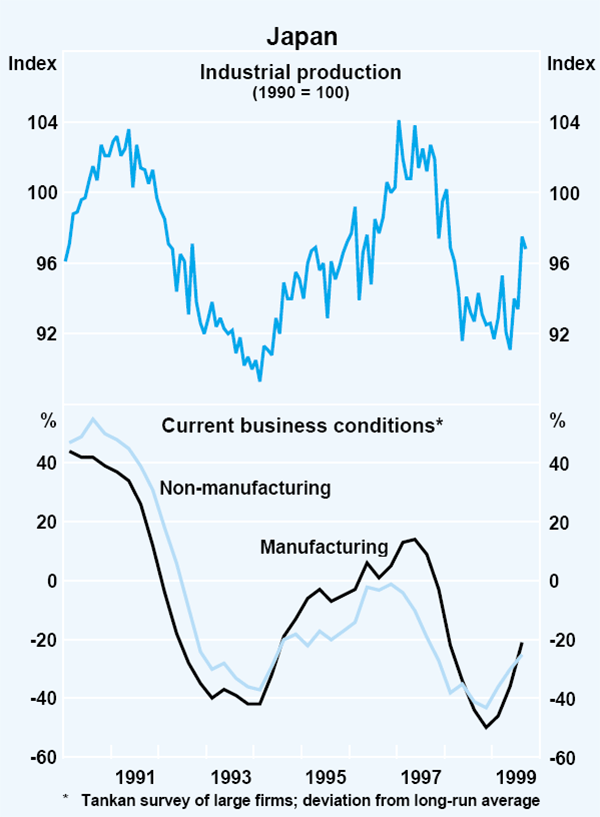
The public stimulus associated with last year's fiscal package looks to be abating, with direct government spending subtracting from growth in the June quarter for the first time in a year. Recent data on public construction expenditure point to a further decline in the September quarter. The government is expected to release details of a new fiscal stimulus package in November.
Excluding the effects of the volatile fresh food component, consumer prices remain relatively stable. Earlier fears of a deflationary spiral appear to have been allayed, but with a considerable output gap to close, there is little prospect of demand-induced price rises for some time.
Non-Japan Asia
The recovery across non-Japan Asia that began in the second half of 1998 has continued this year. For many of these economies, GDP is approaching or exceeding pre-crisis levels (Graph 2). The exceptions are Indonesia and Thailand, where the financial problems have generally proven to be less tractable, and Hong Kong, where growth has been constrained by high real interest rates and the decline in asset prices. But even in these three countries, output has increased noticeably from its trough.
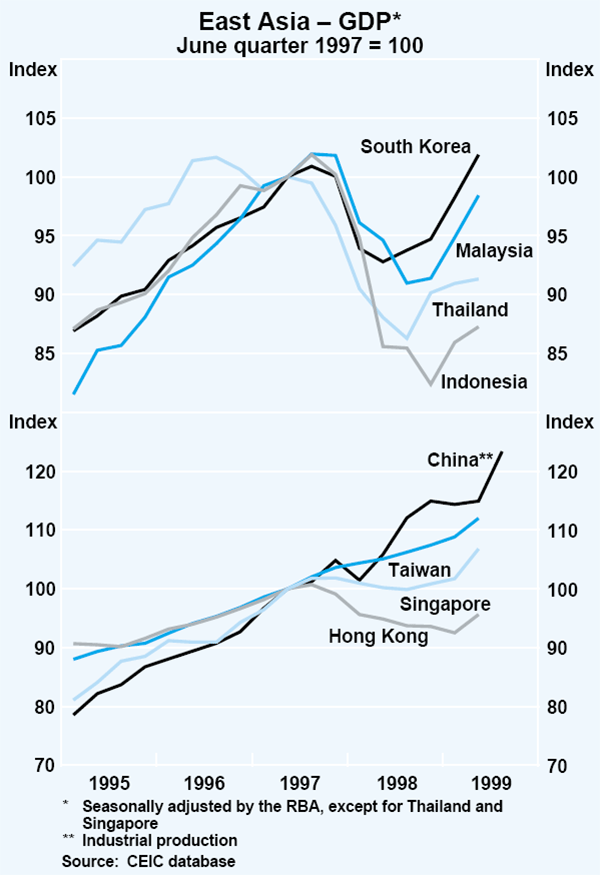
The main contributor to the recovery thus far has been the increase in domestic demand, particularly private consumption. Fiscal policy has been supportive of growth through both direct expenditure and indirect stimulus, including tax cuts and subsidised loans. To date, some of the increase in demand has been met by a rundown in stocks, but as stocks are now at relatively low levels, demand should increasingly be met through higher production.
After relatively subdued growth over 1998, exports are providing a larger boost to activity. This has reflected the rebound in intra-regional trade over the first half of this year, fostered by the pick-up in domestic activity across Asia, and also strong growth in exports to Japan (see Box A). The upturn in global electronics demand has also aided the recovery in Asian exports – particularly in South Korea, Malaysia and Taiwan, where electronics account for 20–30 per cent of production and 30–50 per cent of exports. In South Korea, while industrial production is now 16 per cent above its pre-crisis peak in September 1997, electronics production is 77 per cent higher; excluding electronics, production is just below pre-crisis levels.
The cyclical upswing in activity and the inflow of capital should assist in the restructuring of the financial and corporate sectors in the troubled countries of Asia. In general, structural reform has been more advanced in the financial sector, where financial institutions are being recapitalised and problem loans are being stripped from their balance sheets. Progress in corporate restructuring has proved harder: changes have been made to bankruptcy legislation, but corporate debt restructuring is proceeding only at a slow pace.
Consumer price inflation remains subdued throughout the region (Table 3). This reflects both the substantial excess capacity remaining in most countries in the aftermath of the crisis and also the stabilisation and, in some cases, appreciation of currencies over the past year. Inflation generally peaked during the course of last year and has since moved back to or below pre-crisis rates.
| September qtr 1997 |
September qtr 1998 |
September qtr 1999 |
|
|---|---|---|---|
| China | 2.1 | −1.4 | −1.2 |
| Hong Kong | 6.1 | 2.3 | −5.0 |
| Indonesia | 6.4 | 76.3 | 6.6 |
| Japan | 2.2 | −0.2 | 0.0 |
| South Korea | 4.0 | 7.0 | 0.7 |
| Malaysia | 2.3 | 5.7 | 2.3 |
| Philippines | 4.8 | 10.4 | 5.6 |
| Singapore | 2.3 | −0.8 | 0.9 |
| Taiwan | 1.1 | 0.6 | 0.3 |
| Thailand | 6.2 | 8.1 | −1.0 |
|
Source: CEIC database |
|||
Having grown strongly in the early part of 1999, the New Zealand economy contracted by 0.3 per cent in the June quarter, reflecting a sharp fall in exports and weakness in private consumption. This was partly offset by a significant pick-up in stockbuilding and continued strong growth in interest-sensitive areas of the economy, particularly housing. Subsequent indicators suggest that the weakness in private consumption should be only temporary.
The Americas
The United States economy is continuing to defy most expectations by growing at a pace somewhat above its longer-run trend, even taking account of recent upward revisions to estimates of this trend. Consumer spending continues to drive the expansion in domestic demand, increasing at a rate of almost 5 per cent a year for the past two years (Graph 3). Real household incomes have been increasing at a slower, but still above trend, pace of almost 4 per cent a year. The consequent decline in the measured household saving rate is, in part, a result of spending financed by gains in the stock market. The shift to budget surpluses at the federal level has raised public saving, so that the US national saving rate has been relatively constant in recent years. There have been signs of moderation in the housing sector. The increase of around 1 percentage point in long-term interest rates over the course of this year was associated with a fall in dwelling investment in the September quarter. At this stage, however, the slowing remains mild.
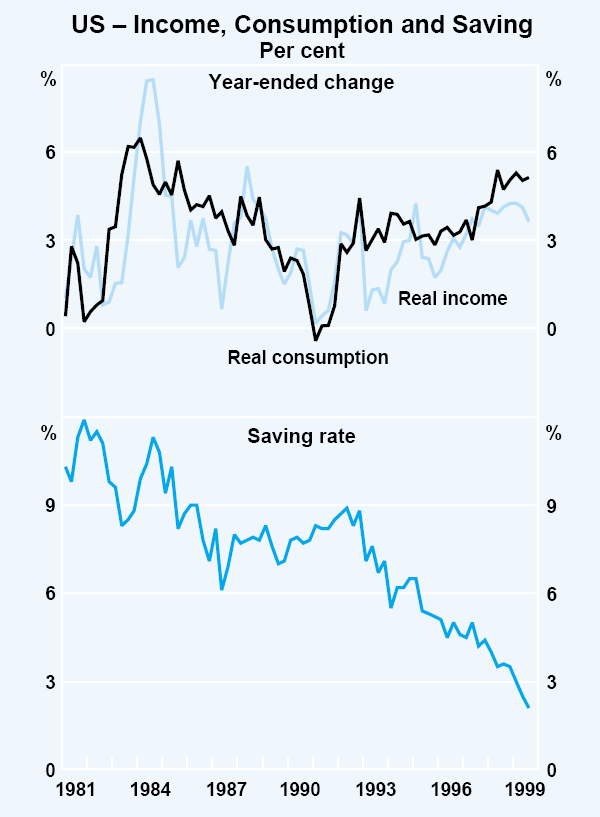
The pick-up in activity elsewhere in the world has been reflected in stronger US exports. Nevertheless, this improvement in exports has not been sufficient to curtail the rise in the trade deficit, as imports have continued to rise sharply with the strong growth in domestic demand as well as the increase in oil prices. This has resulted in an increase in the current account deficit to around 3½ per cent of GDP in the June quarter.
Higher oil prices have pushed up both producer and consumer prices in recent months, with consumer price inflation rising to 2.6 per cent over the year to September. Apart from energy prices, consumer price inflation has edged lower, to be 2 per cent over the year to September. Low overall inflation has, to a large extent, been a result of relatively subdued growth in unit labour costs. This, in turn, reflects ongoing restraint in wages growth, despite the low unemployment rate, and productivity growth that is unusually strong for this stage of the economic cycle. Changes to the method of calculating the CPI have also probably lowered the inflation rate a little over the last year. Looking forward, some of the factors which have held down inflation over recent years are no longer present, including the decline in import prices that was associated with the appreciation of the US dollar.
As noted in the chapter on ‘International Financial Markets’, the Federal Reserve raised interest rates in June and August, reflecting the improvement in international economic and financial conditions, as well as the persistent strength of domestic activity. In October, it announced a bias to tighten.
Low interest rates and the sustained strength of the US economy have led to robust output growth so far this year in Canada, with GDP growing at an annualised rate of 3.8 per cent over the six months to June. Economic conditions in many Latin American economies are continuing to improve. In Brazil, output increased by 0.9 per cent in the June quarter after a similar increase in the first quarter. In Argentina, after contracting sharply in the six months to March, the economy has shown signs of growth more recently. Nevertheless, activity there remains vulnerable to recent increases in interest rates needed to maintain the exchange rate peg to the US dollar. Mexico has recovered strongly this year, a reflection of its close ties to the US economy.
Europe
The pace of activity in the euro area looks to have increased in recent months, after subdued growth over the first half of this year. Export demand, which had been the main constraint on growth earlier in the year, has started to pick up. Reflecting this, and the continued growth in domestic demand, business confidence has recovered in recent months, with expectations about future business conditions being particularly strong. Conditions for consumer spending also remain favourable, with low interest rates and relatively high levels of consumer confidence, especially in France.
Growth outcomes continue to diverge between countries in the region. Output in the smaller euro area countries continues to grow at a fast pace, and growth in France has been slightly above trend over the past year. In contrast, Germany has been one of the weakest economies in the region, recording no growth in the June quarter, although there are a number of indications that economic conditions are now improving.
Consumer price inflation in the euro area remains low. The harmonised measure of inflation remains around 1 per cent – as it has done for most of this year – despite the recent increase in oil prices. Inflation remains somewhat higher in the smaller countries in the region, reflecting their faster growth. With the recovery consolidating across the region, the European Central Bank raised interest rates by 50 basis points to 3 per cent in November.
Growth in the United Kingdom has picked up over the course of this year, following a period of subdued growth when the strength in the pound adversely affected the tradeable sector. Domestic demand, particularly private consumption, continues to grow at a solid pace, reflecting low interest rates and strong growth in household incomes. Conditions in the labour market remain tight. The Bank of England raised interest rates by 25 basis points at both its September and November meetings. Core consumer price inflation is just over 2 per cent, but is forecast by the Bank of England to rise back to the target of 2.5 per cent in two years' time.
Box A: Recent Developments in Asian Trade
One of the major adjustments that the countries in non-Japan Asia have undergone in the past two years has been a significant shift in their current account balances. In the first half of this decade, many countries in the region ran sizeable current account deficits. Shortly after the onset of the Asian financial crisis in mid to late 1997, these current account deficits shifted to large surpluses (Table A1). In some countries, the size of the adjustment in the external position was as much as 10–15 per cent of GDP.
| 1990–96 | 1997 | 1998 | 1999(a) | |
|---|---|---|---|---|
| Thailand | −7.0 | −2.0 | 12.8 | 8.8 |
| Malaysia | −5.5 | −5.1 | 12.9 | 11.7 |
| Philippines | −4.0 | −5.3 | 2.0 | 2.2 |
| Indonesia | −2.6 | −1.8 | 4.0 | 2.4 |
| South Korea | −1.7 | −1.7 | 12.5 | 5.9 |
| China | 1.2 | 3.8 | 3.4 | 1.3 |
| Hong Kong(b) | 3.3 | −3.2 | 0.7 | 1.5 |
| Taiwan | 4.3 | 2.7 | 1.3 | 2.6 |
| Singapore | 12.8 | 15.7 | 20.9 | 21.1 |
|
(a) Estimates from IMF World Economic Outlook, October 1999. Sources: IMF and CEIC databases |
||||
Much of the initial adjustment in these current accounts took place through a sharp decline in imports (Graph A1), primarily reflecting the contraction in domestic demand in most of these economies. While import prices fell in US dollar terms, there was also a significant reduction in import volumes. Exports initially showed a small decline in US dollar terms, and little change in volumes. Some of this initial weakness in exports was caused by the substantial fall in regional demand (as discussed below), while some was attributable to supply-side factors, in particular the difficulty in obtaining trade finance.
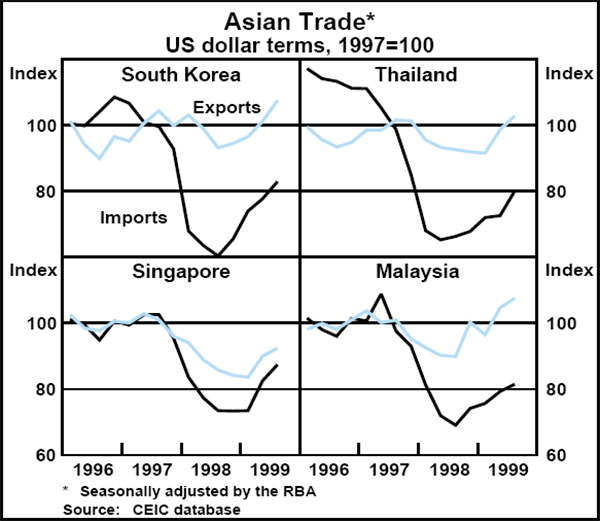
Since mid 1998, the current account surpluses have narrowed in a number of these countries as spending on imports has rebounded, in line with the improvement in domestic demand conditions. In most of these countries, import prices have been relatively stable in US dollar terms since early 1998. More recently, export volume growth has increased, reflecting the pick-up in demand within the region and also stronger global demand for electronics (see main text).
Trends in the direction of trade
The weakness in exports in 1997 and 1998 resulted mainly from the contraction in demand across non-Japan Asia and the depressed state of demand in Japan (Table A2).
| Share of 1996 total |
Annualised growth | |||
|---|---|---|---|---|
| Average 1994–96 |
Sep 97– Dec 98 |
1st half of 1999 |
||
| Exports | 14.6 | −7.6 | 14.8 | |
| Intra-regional | 35 | 18.8 | −18.6 | 20.4 |
| Rest of world | 65 | 12.6 | −1.4 | 12.3 |
| of which: | ||||
| – United States | 19 | 9.7 | 3.7 | 16.8 |
| – Europe | 15 | 16.7 | 7.5 | −3.5 |
| – Japan | 13 | 13.8 | −12.3 | 21.9 |
| – Other | 18 | 11.4 | −5.9 | 16.4 |
| Imports | 14.9 | −16.7 | 15.1 | |
| Intra-regional | 28 | 18.8 | −18.6 | 20.4 |
| Rest of world | 72 | 13.6 | −16.0 | 13.0 |
| of which: | ||||
| – Japan | 19 | 9.8 | −22.5 | 29.0 |
| – United States | 15 | 15.9 | −17.1 | 9.0 |
| – Europe | 14 | 17.2 | −21.3 | 0.8 |
| – Other | 24 | 13.9 | −6.5 | 11.1 |
|
(a) Seasonally adjusted by the RBA Source: CEIC database |
||||
Intra-regional trade accounts for one-third of non-Japan Asian trade. The fall in this trade between mid 1997 and end 1998 accounted for nearly all of the decline in exports in US dollar terms. Since then, stronger demand conditions within the region have seen intra-regional trade rebound, increasing in US dollar terms at an annual rate of 20 per cent over the first half of this year; only Indonesia and Hong Kong have not recorded an increase in exports to other countries in the region.
In the 18 months after the onset of the crisis, exports to countries outside the region declined only slightly in US dollar terms, and continued growing in volume terms. However, there have been significant shifts in the composition of external trade. A sharp fall in exports to Japan was largely offset by continued growth in exports to the US and Europe. Subsequently, as exports to the rest of the world have rebounded, the compositional change during the crisis period has partly been reversed; export growth to Japan has been particularly strong, reflecting the increase in private demand there, while exports to Europe have fallen.
While the decline in imports during the crisis period was evident in all markets, the subsequent recovery has been more uneven. Imports from other countries in the region have rebounded sharply, and, in particular, imports from Japan have grown strongly so far this year. Imports from Europe have lagged well behind the average.
International Financial Markets
The past six months have seen world financial markets continue to adjust to the passing of the financial and economic crisis that began in Asia in mid 1997. The sharp recovery in most emerging markets, particularly in share markets and currencies, that took place over late 1998 and into the first few months of 1999 has consolidated. But the impact of the changing economic outlook has spread beyond these markets to the core developed countries. With growth prospects for the world economy being revised up and inflation no longer falling, short-term market interest rates have risen on the expectation that central banks will unwind the accommodative monetary policy they had put in place over the previous year or two (Graph 4).
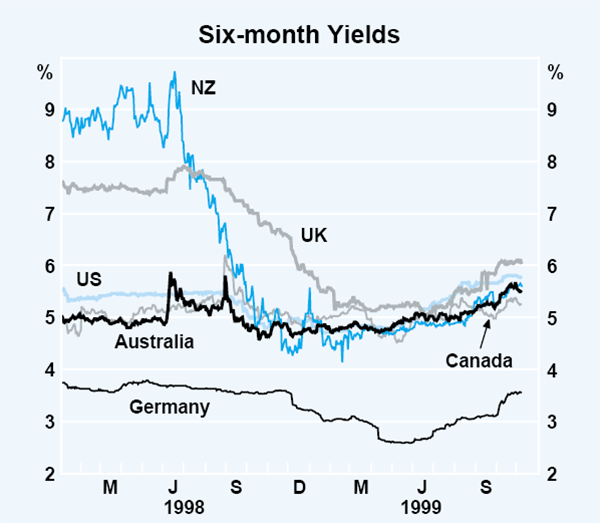
In the US, the tightening phase traces its beginnings to the May meeting of the Federal Reserve, where a change in view on the balance of risks to inflation was signalled with the introduction of a tightening bias. Subsequently, with continuing strong activity indicators, stretched labour markets and signs of possible pipeline price pressures (although core consumer prices remain benign), the Federal Reserve tightened monetary policy by 25 basis points to 5 per cent in June and then 5.25 per cent in August (Graph 5). And at its October meeting, it reintroduced a bias to tighten. The Federal Reserve has now reversed two-thirds of the cut in interest rates made last year in the wake of the Russian financial crisis. The Bank of England followed the Federal Reserve by increasing its official interest rates by 25 basis points to 5.25 per cent in September, and another 25 basis points to 5.50 per cent in November. The European Central Bank raised official rates in November by 50 basis points, to 3.00 per cent, reversing all of the precautionary easing of last April. The Danish central bank also raised official rates in November, by 45 basis points to 3.30 per cent.
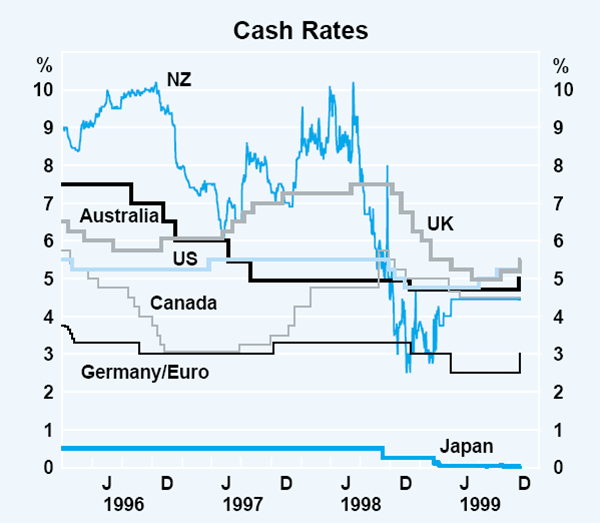
Japan remains an exception to this, with markets expecting that the Bank of Japan will maintain its very accommodative monetary policy (which involves cash rates of close to zero) for the foreseeable future.
Bond yields have risen in all major countries. In the US, they are up by about 180 basis points since their safe-haven related lows in October last year following the Russian default, the near collapse of Long-Term Capital Management, and subsequent problems in Latin America (Graph 6). In Europe, while the rise in yields was a little slower to occur, it has picked up pace in the last three months as signs of economic recovery in Europe have strengthened, and the net rise in yields from the early 1999 lows is now about 140 points. In Japan, bond yields have risen by around 60 basis points since late 1998, notwithstanding the accommodative monetary stance of the Bank of Japan. A factor pushing yields higher in Japan has been the large supply of bonds coming onto the market to fund the budget deficit. Notwithstanding this rise, bond yields in Japan remain at historically low levels, with 10-year yields at 1.8 per cent.
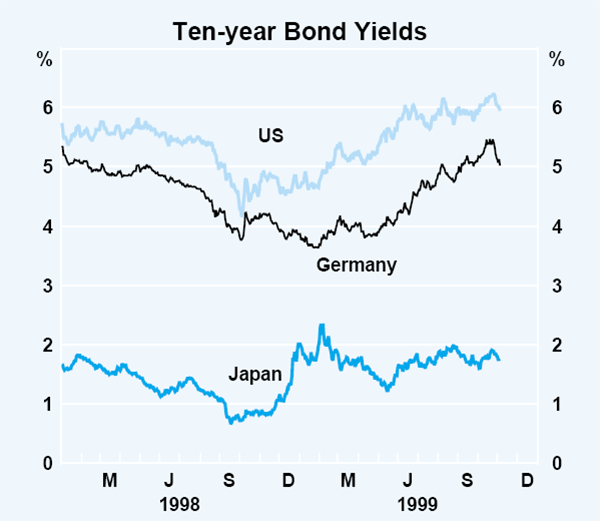
In credit markets more generally, perceptions that the interest rate cycle has turned, together with preparations for Y2K, have led borrowers to bring forward borrowing to lock in funding. The resulting increase in corporate bond issuance has pushed up swap spreads, with the spread on US 10-year (bank/government) swaps, for example, recently at its highest level for several years (Graph 7).
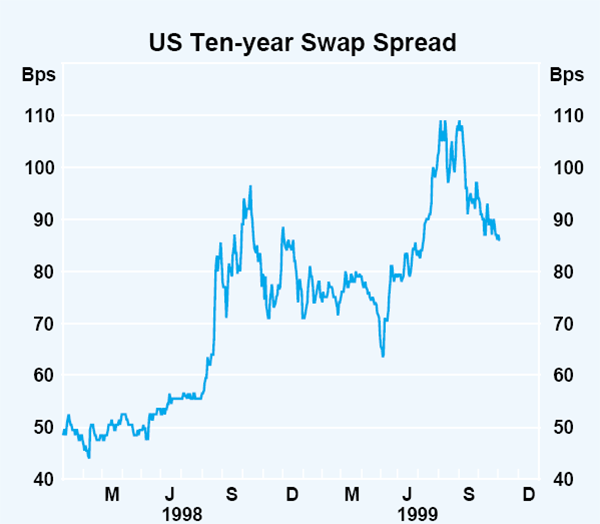
Higher bond yields have had a dampening influence on share markets around the world in recent months. In the US, the S&P500 is about 4 per cent below its July peak, but the bulk of stocks in the index have fallen by significantly more than this as investors, possibly reacting to concerns that share prices are overvalued, have tended to move into the larger ‘blue chip’ stocks. More than half the stocks in the S&P, for example, have fallen by 20 per cent or more from their peaks. Demand for ‘high-tech’ stocks also seems to have held up better than average. The Nasdaq share price index, for example, which contains a high weighting of such stocks, is around all-time peaks, and up over 35 per cent from its level at the start of 1999. In general, however, the US share market has become significantly more volatile in recent weeks, with daily price changes of 1 to 2 per cent becoming a regular feature. Inflows into equity mutual funds have slowed sharply.
Share markets in most other developed countries have generally followed the US lead (Graph 8). One exception to this is the Japanese share market, which has been stronger than markets elsewhere, driven by the sharp upward revision to the economic growth outlook for the Japanese economy. The Nikkei index has risen by more than 30 per cent in 1999, although in recent months it, too, has tended to flatten out.
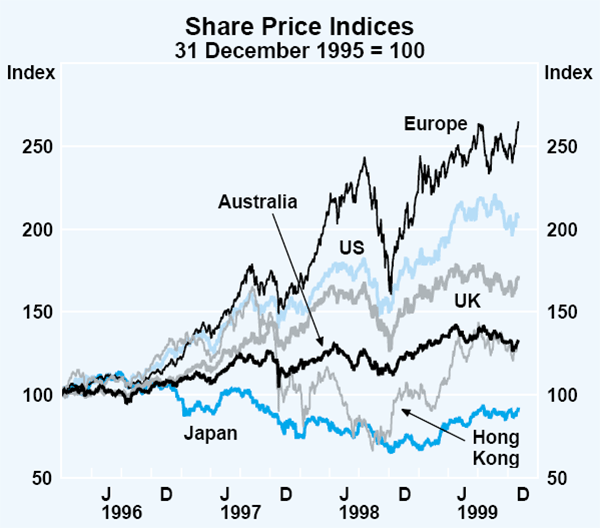
Foreign exchange markets have been subject to strong pressures in recent months in response to the cyclical turnaround in Japan and Europe. The yen in particular has appreciated markedly as foreign investors have restored exposures after being underweight for some time (Graph 9). Japanese investors are also reported to have repatriated funds from offshore investments. Japanese authorities have been concerned about the effects of yen strength on Japan's emerging recovery and intervened a number of times, especially in June and July. The currency is now about 15 per cent stronger in net terms against the US dollar than six months ago and about 30 per cent stronger than the exceptional rate reached a little over a year ago. The euro has also been showing signs of strength since July, after falling consistently over the first half of the year. Its rise has coincided with evidence from the core European economies that economic growth has increased.
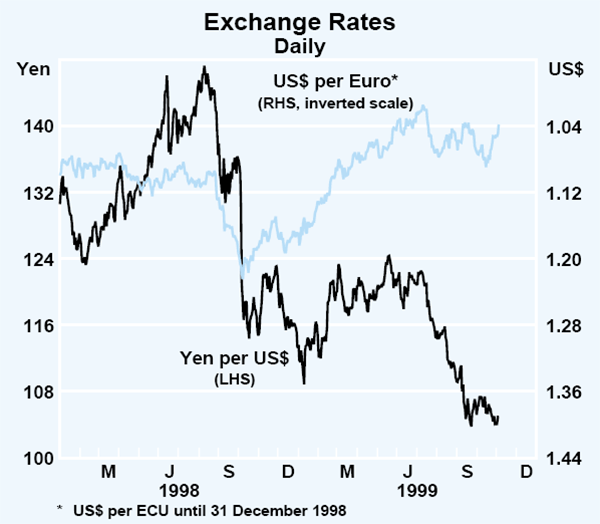
In emerging markets over the past six months, the general picture has been one of consolidation after the earlier sharp recovery. Markets in Asia have been fairly stable, although concerns that the pace of banking reform may not be sufficient led to a 6 per cent fall in the Thai baht in September. Much of this fall was subsequently reversed as the general run of economic news out of Thailand continues to be favourable. There was also substantial volatility in Indonesian markets, mainly reflecting political developments, but there was little spill-over to other regional markets. Another significant development was the announcement by the Hong Kong Monetary Authority that it would start to dispose of shares it had purchased to support the market when it came under an intense speculative attack in August 1998. Shares purchased for HK$118 billion, have since increased in value to over HK$200 billion. Disposal of the shares will be by the sale of units in a trust set up to hold the shares. The initial public offering of units will be for HK$10 billion.
Periodic financial market disturbances continue to disrupt a number of Latin American financial markets, where recovery in growth is much more patchy than in Asia. Currencies in particular have been under pressure (Graphs 10 and 11). The Colombian and Chilean pesos were floated in September after periods of speculative attack (although the Colombian peso has recovered a little since), the Brazilian real fell on continuing budget imbalances and US dollar debt servicing and Ecuador's sucre has been under pressure following that country's default on some foreign debt and persistent domestic stagflation. While interest rates are well below their peaks in the recent crisis, they remain high in many Latin American countries. Stock markets are also off their peaks for the year.
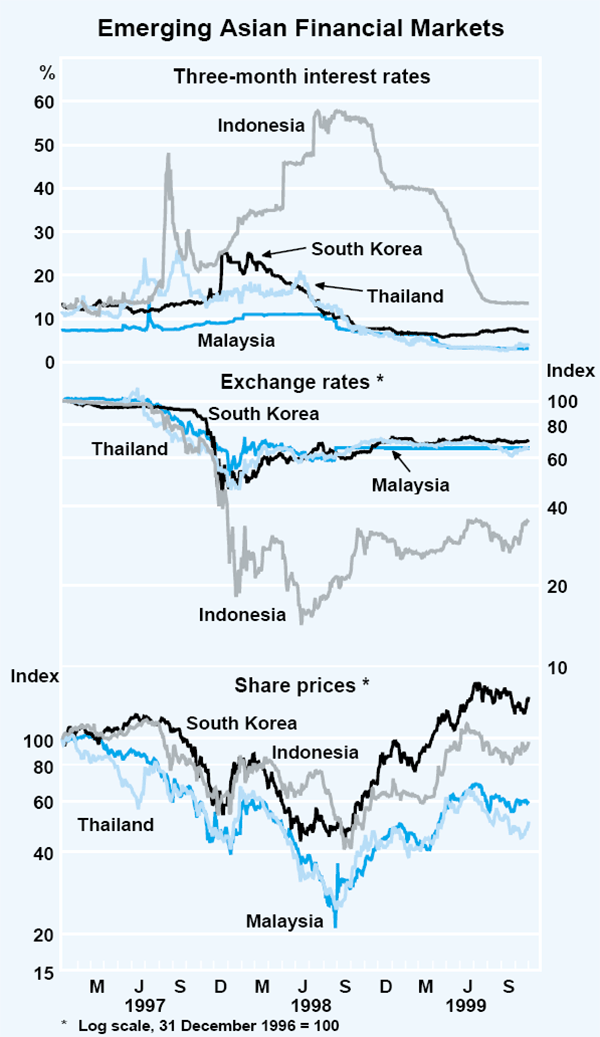
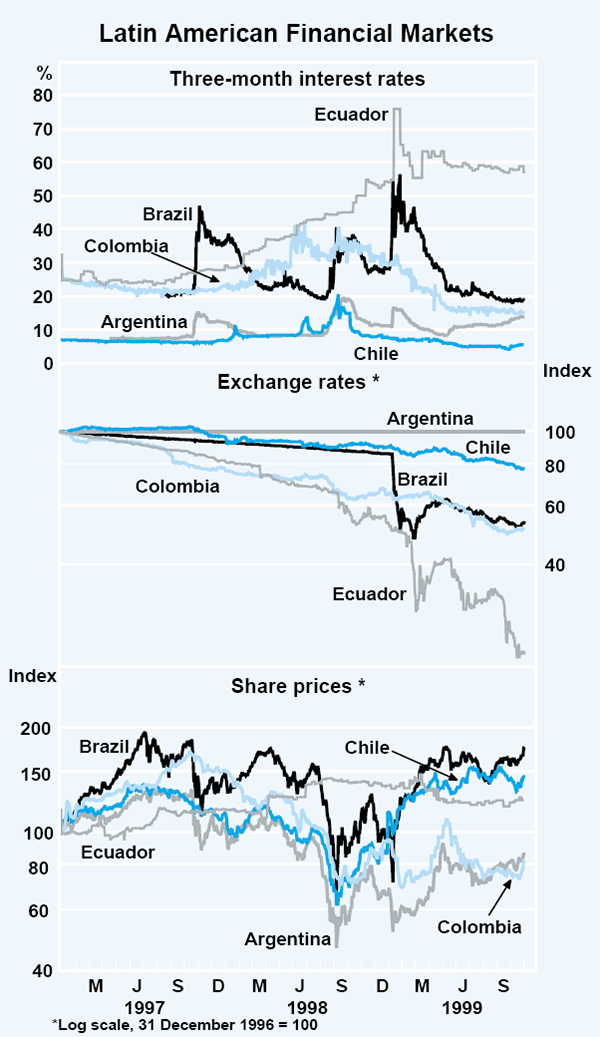
Domestic Economic Activity
The Australian economy has continued to grow strongly during 1999 (Graph 12). Real output expanded by around 4 per cent over the year to the June quarter, with continued strength in domestic demand offsetting the weakness in exports (Table 4). These figures record that for the past three years the Australian economy has been growing at above 4 per cent, and it is now in the ninth year of the current upswing.
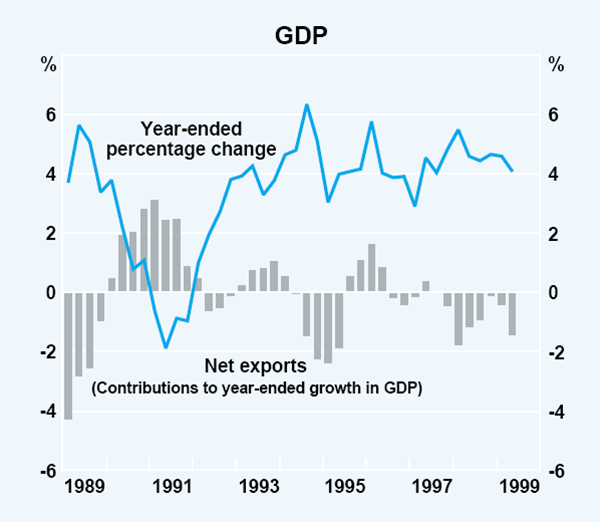
| Six months to: | Year to June 1999 | ||
|---|---|---|---|
| December 1998 | June 1999 | ||
| Private final demand(a) | 3.4 | 4.8 | 4.1 |
| Consumption | 4.9 | 4.8 | 4.9 |
| – Goods | 2.6 | 2.8 | 2.7 |
| – Other(b) | 6.8 | 6.3 | 6.6 |
| Dwelling investment | 2.9 | 1.3 | 2.1 |
| Business investment(a) | −3.0 | 5.8 | 1.3 |
| – Machinery and equipment(a) | −15.3 | 14.4 | −1.6 |
| – Buildings and structures(a) | 15.4 | −15.0 | −1.0 |
| Public final demand(a) | 6.9 | 2.6 | 4.8 |
| Change in inventories(c) | −0.6 | 2.4 | 0.9 |
| Net exports(c) | 0.1 | −2.9 | −1.4 |
| Gross domestic product | 4.8 | 3.3 | 4.1 |
| (a) Excluding transfers between the public and private sectors (b) Excluding dwelling rent (c) Contributions to growth in GDP |
|||
Recent indicators suggest that private demand has continued to grow at a robust rate, with a pick-up in both consumer spending and housing activity, following an apparent moderation in growth in the June quarter. Latest data also suggest that the weak period of export growth, still evident in the first half of 1999, may have come to an end. This is largely a result of an improvement in Australia's external trading environment. Prospects are, therefore, that output growth will remain strong over the year ahead.
The pace of output growth in 1998 and 1999 has been sufficient to generate continued growth in employment. This has, in turn, boosted household incomes, and along with the high levels of household wealth and consumer confidence, it has established favourable conditions for continued growth in consumption. The business environment also appears to have improved over recent quarters, with most business surveys reporting an improvement in business confidence and expected profitability. Although investment has been weak, the investment intentions data imply that most of the decline in business investment has already occurred.
Household consumption, income and wealth
Over the first half of 1999, consumer spending grew at an annual rate of 4.8 per cent, around the same pace as was recorded in the second half of 1998. Underlying these figures, however, was a decline in recorded consumption growth during the June quarter, affecting most categories of consumption. Some moderation was expected from the high rates of growth recorded in the previous few quarters, when consumer spending appeared to be boosted by the demutualisation of the AMP Society and capital gains flowing from the sale of the first tranche of Telstra. To some extent the June quarter outcome may also reflect difficulties with seasonally adjusting the data: the early incidence of Easter brought some sales forward into the March quarter, while the increasing popularity of mid-year sales has pushed some sales back into the September quarter.
Indicators suggest that consumer spending has continued to grow strongly in recent months (Graph 13). The volume of retail sales increased by 2.6 per cent in the September quarter, and by nearly 6 per cent over the past year. The strength of retail trade has been broadly based, with growth in some of the more discretionary items of expenditure, such as durable household goods and recreational goods, being particularly strong.
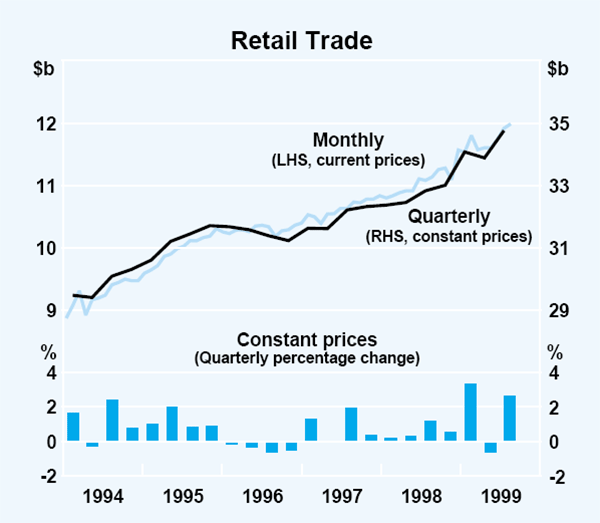
One important factor sustaining consumption in recent quarters has been the high level of consumer confidence. The Westpac-Melbourne Institute index of consumer sentiment picked up through late 1998 and early 1999 and has maintained a high level since then (Graph 14). Consumers are now more optimistic about their situation than they were even before the onset of the Asian financial crisis. In recent months, consumers have become increasingly positive about economic conditions more generally, although they have become more uncertain about whether now is a good time to buy a major household item, possibly reflecting a degree of uncertainty about the net effect of the Government's tax changes on prices.
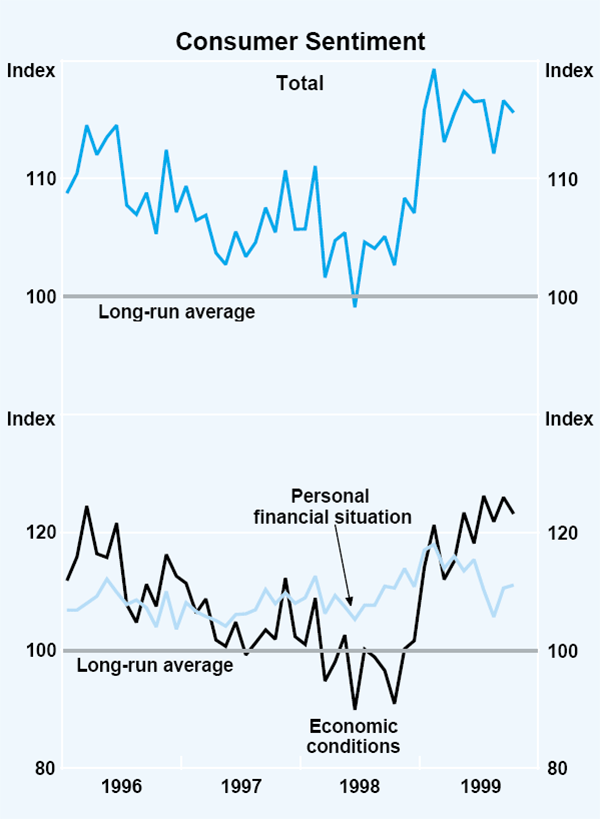
The one area of consumption that has weakened this year is sales of motor vehicles. Although competition between motor vehicle companies remains vigorous, registrations have declined by about 10 per cent since the middle of 1999 and are more than 20 per cent below the peaks recorded in mid 1998. In part this decline was expected, as registrations had reached a very high level in 1998. Some temporary decline during 1999/2000 is also expected by the industry on account of the introduction of the GST next year.
Consumption spending over recent quarters has been supported by continued growth in household incomes. Growth in household disposable income picked up steadily over the past year, driven by solid employment growth, to be running at just under 6 per cent over the year to the June quarter, the highest rate of increase for almost three years. Over the next year, income should continue to be supported by employment growth, and from July 2000, it will be boosted by the foreshadowed reductions in income taxes and increased transfer payments.
An additional factor explaining the continued strength of consumption over the past couple of years has been the strong increase in household wealth. In large part this has been driven by growth in share prices and house prices, although the demutualisation of the AMP Society and capital gains from the first stage of the Telstra float provided an additional boost to available wealth last year. In recent quarters, share prices have weakened, while dwelling prices have continued to rise steadily (discussed below). In aggregate, gross household wealth is estimated to have grown by 9 per cent over the year to June (Table 5). The likely effect on wealth of the Telstra 2 float is less clear, given the smaller discount given to retail investors. Nonetheless, the level of wealth relative to income has increased considerably in recent years, while the ratio of consumption to wealth has declined (Graph 15). This could support above average growth in consumption in the period ahead.
| Level $b | Share of total wealth |
Year-ended growth |
Average annual growth since June 1995 |
||
|---|---|---|---|---|---|
| Per cent | |||||
| Dwellings | 1,484 | 55.8 | 9.3 | 10.5 | |
| Consumer durables | 118 | 4.5 | 4.0 | 3.3 | |
| Financial assets | 1,056 | 39.7 | 9.1 | 10.4 | |
| of which: | |||||
| – Equities | 182 | 6.9 | 21.2 | 15.6 | |
| – Superannuation and life offices | 544 | 20.5 | 7.5 | 10.5 | |
| – Other | 330 | 12.4 | 5.9 | 7.7 | |
| Total wealth | 2,658 | 100.0 | 9.0 | 10.1 | |
|
Sources: ABS; CBA/HIA Housing Reports |
|||||
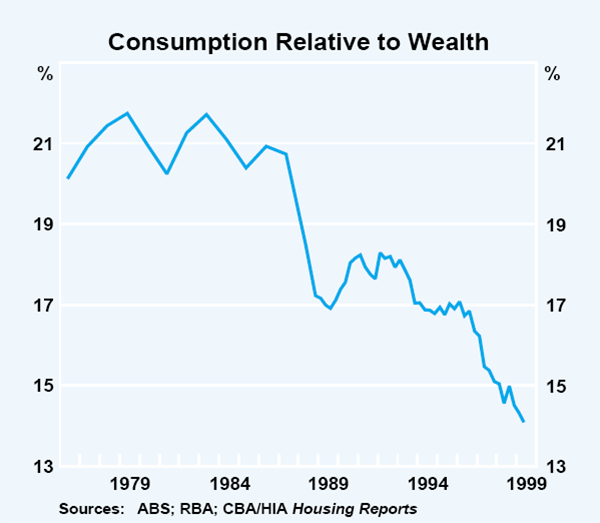
The strength of wealth and income, developments in financial products, low interest rates and high levels of consumer confidence have all encouraged further household borrowing. Annualised growth in credit outstanding to households increased to more than 15 per cent over the six months to September. It has been boosted in recent months by borrowing for purchases of Olympic Games tickets and Telstra 2 shares. Margin lending by banks and brokers for the purchase of shares by individuals has been growing strongly. Such lending has increased by 38 per cent in 1999, to about $5.2 billion. Although it is less than 2 per cent of total household debt, growth in margin lending has accounted for over a fifth of the rise in banks' personal lending (excluding credit cards) since 1996.
Continued strong growth in financial institutions' home loan commitments suggests that ongoing demand for new borrowing remains brisk. The average size of a new home loan has also been rising more quickly than average household incomes.
Overall, the ratio of household debt to the disposable income of households (excluding unincorporated enterprises) has risen by 12 percentage points over the past two years to 94 per cent (Graph 16). Continued strong growth in the household sector's assets, however, has resulted in the ratio of household liabilities to assets remaining roughly stable for the past few years. The household sector's net worth (assets less liabilities) remains at a high level.
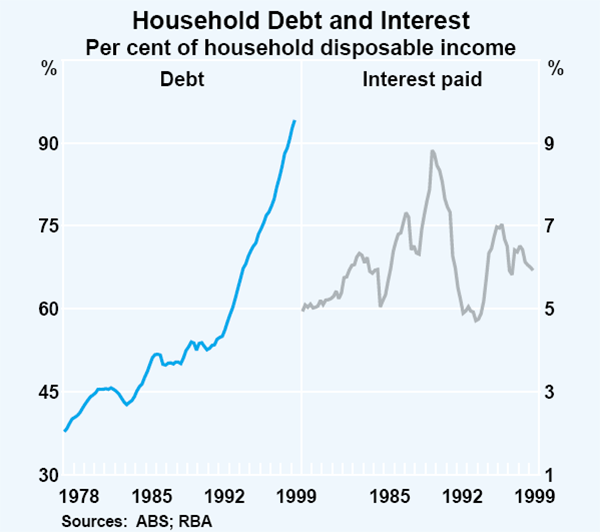
The burden of interest repayments on household budgets remains at moderate levels despite the increase in household indebtedness. The ratio of household sector interest payments to disposable income has fallen steadily over the past year and is now below 6 per cent. This reflects borrowers switching from loan products with higher interest rates, such as traditional fixed-term personal loans, to products which attract lower rates of interest, such as home-equity lines of credit and other borrowing secured by residential property. Interest rates on specific loan products have been fairly stable over the past year, as discussed in the chapter on ‘Domestic Financial Markets’.
The housing market
Dwelling investment was relatively flat through 1998/99 after growing by almost 15 per cent over the previous year. Recent indications, however, suggest that housing activity will pick up over the year ahead (Graph 17). The number of private building approvals has risen by around 5 per cent since the March quarter, driven by strong growth in approvals for houses. The value of private building approvals has exhibited a similar pattern, although growth has been slightly stronger, indicating a rise in the average value of building approvals. Loan approvals picked up ahead of building approvals and have continued to grow strongly in recent months.
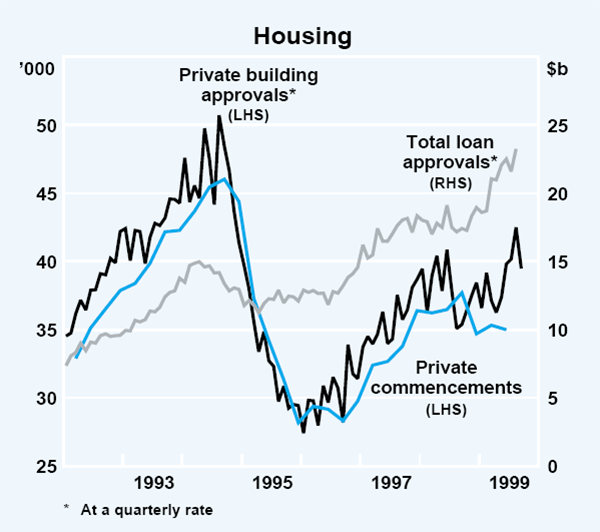
The level of building approvals is now considerably higher than commencements, which suggests that the industry is operating near full capacity, at least in some parts of the country. It also implies that there is some scope for building activity to rise from current levels.
The forthcoming introduction of the GST is likely to contribute to stronger housing activity in 1999/2000. The construction and sale of new homes, repairs and renovations to existing homes, and transaction costs (such as solicitors' fees) will be subject to the GST from 1 July 2000. While the wholesale sales tax on some materials used in constructing and finishing a house will be removed from that date, there is an incentive for some housing activity to be brought forward before the GST is introduced. This incentive has been offset for some households by the introduction of the First Home Owners Scheme, which provides a grant of $7,000 to households purchasing a dwelling for the first time after June 2000.
The strengthening of housing demand has been reflected in house prices. Established house prices, as measured by the ABS, rose by 2.3 per cent in the June quarter, and by nearly 6 per cent over the year. The REIA series which, unlike the ABS series, does not exclude the upper end of the market, but uses unmatched samples, rose by slightly less than 2 per cent in the June quarter and by just under 9 per cent over the year. Both series suggest that house prices continue to rise most rapidly in Melbourne and Sydney, where prices have risen by over 50 per cent and around 30 per cent respectively since mid 1996, according to the REIA data (Graph 18). Prices also seem to be firming in Perth and Adelaide.
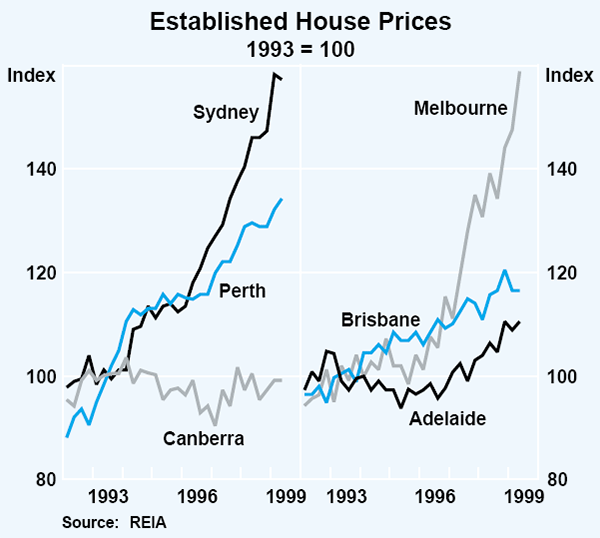
The business sector
The sustained strong growth in domestic demand in recent quarters has ensured that firms servicing the domestic market have enjoyed very favourable conditions. While the threat of competition from abroad has kept up competitive pressures in some sectors and margins tight, healthy growth in sales volumes has meant that overall profitability has been strong. For firms selling into overseas markets, conditions have been more difficult. This is particularly apparent in the performance of the mining sector. Nevertheless, the improvement in the outlook for world growth, particularly in Asia, has improved the prospects for Australian exporters.
The production measure of GDP increased by 0.2 per cent in the June quarter and by 4.2 per cent over the year to the June quarter. The low growth in the quarter came mainly from weakness in agriculture and manufacturing, both of which tend to be volatile. Most of the service industries, including accommodation, cafes and restaurants, communication, and transport and storage showed strong growth, and mining output grew for the second consecutive quarter.
Inventory accumulation picked up in the June quarter, although industry inventory-to-sales ratios do not point to any significant imbalances. Over 1999/2000, the ABS treatment of some Olympic-related expenditure is expected to boost the level of public authority stocks, and hence measured GDP growth. In the September quarter 2000, the Olympic-related stock build-up of the last four years will be unwound, offsetting part of the boost to growth of staging the Olympics.
Business surveys suggest that there has been a further improvement in conditions in most industries (Graph 19). According to the NAB survey, business conditions in the September quarter improved to be at their highest level since 1995, with businesses reporting stronger profits, employment and trading conditions. Current conditions are clearly better than average in the retail industry, consistent with the strength in consumption spending (as discussed above) and, while conditions in the mining industry remain lower than average, they have picked up noticeably over the past six months. Business conditions in the manufacturing industry have also improved, according to the NAB, ACCI-Westpac and Colonial State Bank surveys, presumably reflecting the improved prospects for manufactured exports. This suggests that the weakness in manufacturing evident in the June quarter national accounts data may prove temporary. The available measures of capacity utilisation indicate some increase in the past year, although utilisation remains, at this stage, below the peak recorded in the mid 1990s (Graph 20).
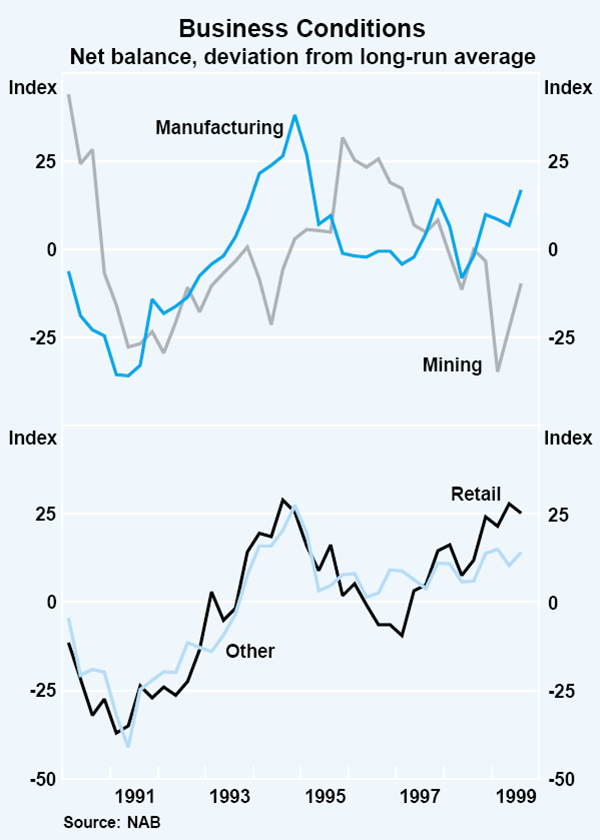
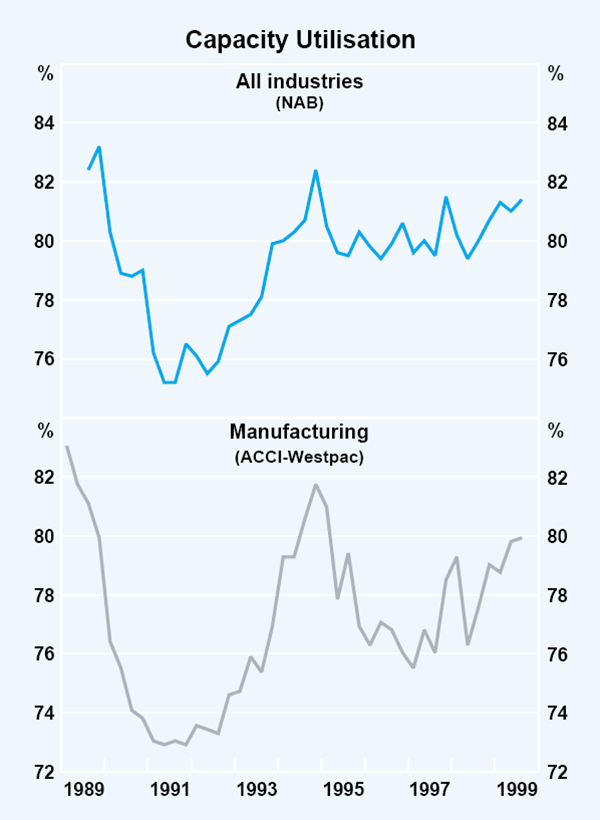
The overall strength of business conditions shown in these surveys has for some time appeared at odds with a weakening of actual and intended business investment. After a number of years of strong growth, private investment expenditure began to level out in the first half of 1998, and it has since fluctuated around a broadly stable level in real terms (Graph 21). This weakening of growth in business investment was accompanied by a series of downward revisions to business investment intentions, as recorded in the ABS Capital Expenditure (Capex) survey, particularly in the second half of 1998 and in the March quarter 1999.
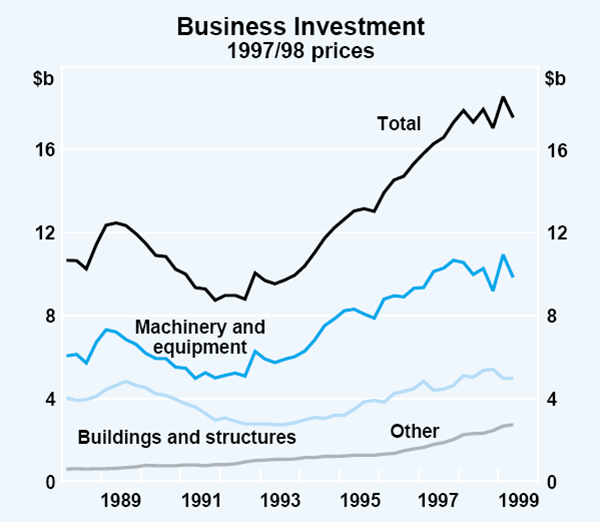
More recently, however, there have been some signs that the investment outlook has begun to improve. While the June quarter Capex survey still implies that the average level of fixed investment in 1999/2000 will be lower than its average in the previous year, the survey indicates that firms have revised upward their expectations since the March quarter – the first upward revision of intentions for some quarters. The survey also suggests that the average level of fixed investment in 1999/2000 will be higher than its June quarter 1999 level; that is, there will be growth over the course of 1999/2000. In that case, much of the weakness in aggregate investment that has been signalled in the intentions data may have already occurred.
The Capex survey points to contrasting prospects for the two main components of business investment. Investment intentions for machinery and equipment were revised up more strongly than the total, with the upward revisions spread across most industry groups. Assuming average realisation ratios, nominal machinery and equipment investment in 1999/2000 is expected to be 6 per cent higher than its June quarter level. In contrast, the outlook for buildings and structures investment is considerably weaker, with a further decline expected on the same basis. The latest Access Economics Property Monitor, however, shows a somewhat more positive picture for non-residential building activity, with fewer projects being downgraded than in the previous survey. Nevertheless, the listing of new projects has slowed.
The third component of business investment, which includes investment in livestock, investment in intangible fixed assets, such as computer software, and mineral exploration expenditure, has grown very strongly over the past few years. It now accounts for 16 per cent of estimated business investment, compared with 11 per cent three years ago. Strong growth in expenditure on computer software, which is around 70 per cent of this category of investment, explains most of this increase. Exploration expenditure, worth a little under 15 per cent, has been declining, consistent with the overall fall in investment by the mining sector.
Developments in the mining sector have had a significant impact on current and prospective investment trends. Mining sector investment comprises around 12 per cent of total investment, and this component fell by nearly 40 per cent between its peak in early 1998 and the June quarter 1999. Although mining sector investment intentions improved a little in the latest Capex survey, they still imply further substantial falls in investment during 1999/2000.
The decline in mining investment has been, in part, a reaction to declining production and profits, caused by falling global demand and lower commodity prices during 1998 and early 1999. However, some contraction in mining investment was to be expected given the exceptionally strong growth that had occurred in previous years. Mining investment grew by around 18 per cent per annum in the period from early 1992 to early 1998, and as a share of GDP it doubled from trough to peak (Graph 22). Non-mining investment, in contrast, grew by 10 per cent per annum, on average, over this period, and as a share of GDP it rose to around its average level since 1980.
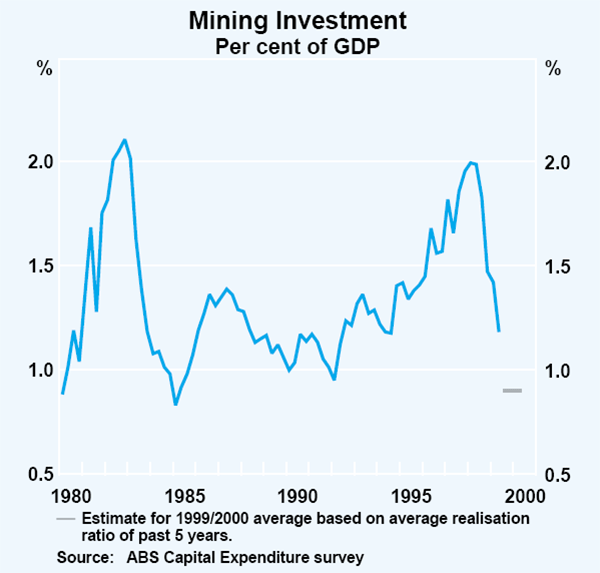
It seems likely that mining investment will reach its low point during the next few quarters. Using a five-year average realisation ratio from the Capex survey, mining investment as a share of GDP in 1999/2000 is expected to reach a similar level to that reached in the 1984/85 mining investment downturn. This would put investment expenditure around the level required to maintain the existing capital stock, and suggests that further falls in mining investment would be unlikely. The recent improvement in the outlook for world growth and the recovery in the prices of oil, gold and base metals, three sectors that comprise almost half of total mining investment, have contributed to an improvement in the mining sector's perceptions of business conditions and expected profitability.
Overall, businesses have ready access to funds. Aggregate corporate profitability remains at a high level, though the growth of profits as recorded in the national accounts has eased during the past year. Gross operating surplus (GOS) increased by 1.3 per cent over the year to the June quarter, with estimates of growth being revised downward to reflect new information on companies' accounting treatment of software. As a share of GDP, however, corporate GOS remains above its decade average.
External funding is also readily available. While business credit growth has fallen in recent months, this weakness has been partly offset by growth in alternative sources of business funding, and surveys do not report businesses being constrained by a lack of funds. The value of equity raisings over the first nine months of this year was around 60 per cent higher than for the same period last year. New floats have been particularly strong in recent months. The corporate sector has also re-entered the market for non-intermediated debt funding, with net issues of debt securities by the non-financial corporate sector averaging just under $1 billion per month in the nine months to September. So far this year, issuance is three times higher than in the same period last year.
The rural sector
Farm output is expected to increase modestly in 1999/2000 following a strong rise in 1998/99 of around 8 per cent. The prospects for wheat, canola, sugar and dairy are favourable, while meat, wool, cotton and barley production are expected to fall. Following an increase in wheat production in 1998/99 of nearly 9 per cent, the Australian Bureau of Agricultural and Resource Economics expects to see a further rise in 1999/2000 of around 4 per cent, reflecting an increase in the area planted and favourable seasonal conditions. The strong growth of canola production results from farmers substituting away from growing other coarse grains in response to the higher returns on canola.
Following two years of historically high meat production, slaughter rates could fall by around 5 per cent as producers begin to rebuild herds. Improved prospects for economic growth in key markets – particularly South Korea – have seen some improvement in the short-term outlook for wool demand. However, wool prices remain weak and ongoing low returns from wool are likely to see farmers reduce sheep numbers further.
The labour market
Employment growth has strengthened noticeably in recent months after a weaker period around the beginning of the year (Graph 23). Over the four months to September, employment increased by 120,000 – more than two-thirds of the total increase in employment that has taken place over the past year. Much of the recent increase has been in full-time employment, implying strong growth in total hours worked. The recent employment growth has been strongest in a number of cyclically sensitive industries, including construction, wholesale and retail trade. Construction employment has been boosted in New South Wales by increased demand for repair work arising from the hailstorm in Sydney last April, but also appears to reflect a more broadly based pick-up in housing construction activity in the September quarter.
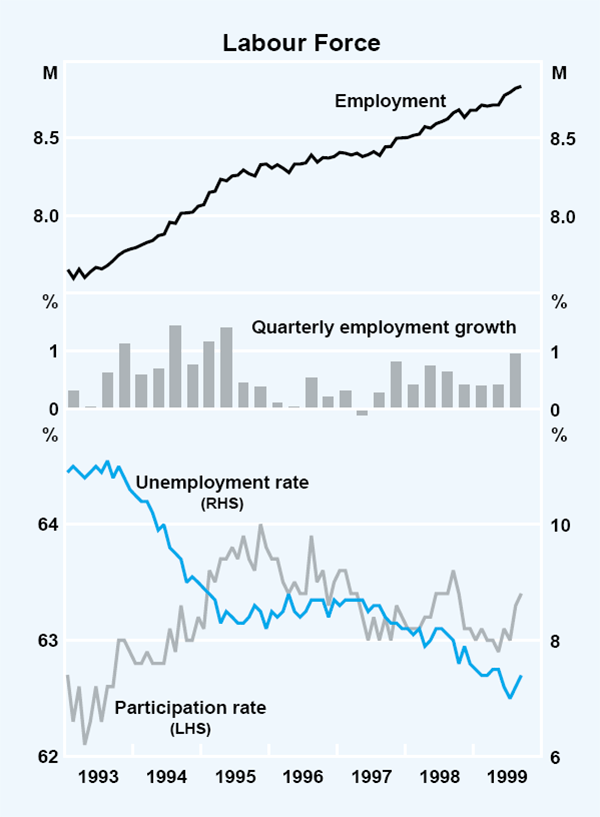
Labour force participation rates have risen in recent months. In September, the participation rate increased to 63.4 per cent of the working-age population, bringing it back to around the level prevailing a year earlier. The recent increase in participation has been associated with some rise in the measured unemployment rate, which had fallen unusually quickly in earlier months. Nonetheless, the overall trend in unemployment during the past year has been clearly downward. Unemployment averaged 7.2 per cent in the September quarter, compared with 8.1 per cent a year earlier.
Current rates of economic growth are likely to generate further declines in unemployment in the period ahead. Forward-looking indicators of employment continue to record levels that have been consistent with a good pace of job creation in the past (Graph 24). According to the NAB survey, businesses' employment intentions are at their highest level for more than four years. The ACCI-Westpac survey of manufacturers recorded a substantial rise in employment intentions, suggesting firmer prospects in coming quarters. The job vacancy surveys conducted by the ABS and the ANZ Bank have again recorded new cyclical highs, with both measures increasing by more than 20 per cent over the past year.
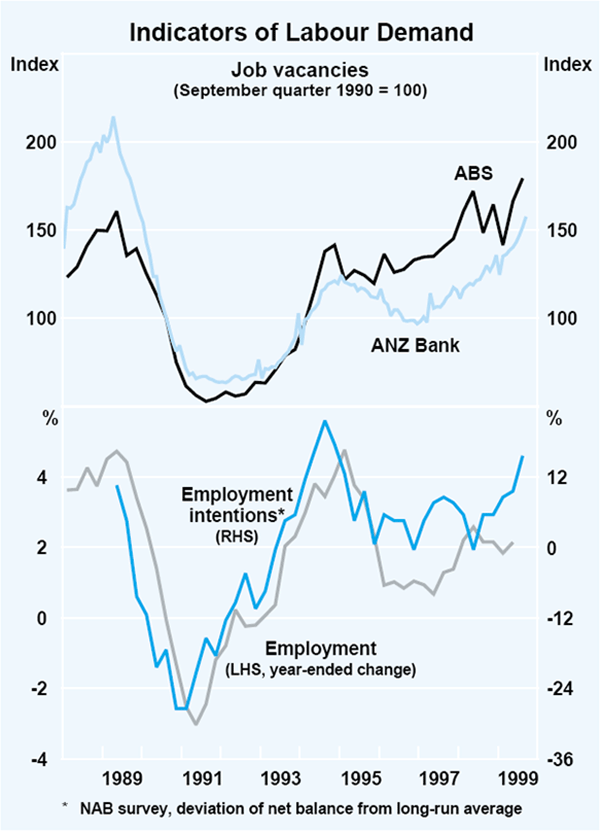
There is a small amount of evidence that the strength of the labour market may be generating skills shortages in some areas. Skilled vacancies, according to the survey conducted by the Department of Employment, Workplace Relations and Small Business, are at historically high levels. Over the past year, there have been significant increases in the number of vacancies in the construction sector. The NAB survey reports that the overall proportion of business respondents citing the availability of suitable labour as a constraint on current output and profitability has been increasing, although the survey still places labour availability well behind other constraining factors. The ACCI-Westpac survey also points to an increase in the number of respondents finding it more difficult to obtain labour; this is currently around the level reached at the previous peak in 1994.
Labour productivity rose by 2.1 per cent over the year to the June quarter 1999, and has maintained an average growth rate of 2.4 per cent during the course of the 1990s economic expansion to date. Despite slowing a little in recent quarters, as employment growth has picked up in response to earlier growth in output, Australia's productivity growth in the 1990s has been higher than in previous expansions. This outcome also compares favourably with that in the United States, often cited as an example of strong productivity performance at present.
Balance of Payments
Export revenues increased by over 6 per cent in the September quarter, after falling by 9 per cent over the year to June. While about a quarter of the increase in exports in the September quarter can be attributed to an increase in oil-related export revenues, the improvement generally reflects stronger demand for other exports from Australia's trading partners (Table 6).
| Year-ended | Quarterly | |||
|---|---|---|---|---|
| June qtr 1997 | June qtr 1998 | June qtr 1999 | September qtr 1999 | |
| US and EU | 14.4 | 26.7 | −5.2 | 4.7 |
| Japan | 1.3 | 8.7 | −11.5 | 9.4 |
| Initial crisis Asia | 10.1 | −19.1 | 9.3 | −3.1 |
| Other east Asia | 3.2 | 5.8 | −16.4 | 14.8 |
| Rest of World | 12.8 | 11.3 | −10.8 | 9.1 |
| Total | 8.4 | 7.4 | −8.0 | 7.1 |
| (a) Excluding gold | ||||
Resource exports, which accounted for much of the weakness in export earnings over 1998/99, rose by around 7¼ per cent in the September quarter (adjusted for re-exports of gold), reflecting increases in both prices and quantities shipped (Graph 25). A large part of this rise in export earnings reflected the higher price of oil and the resumption of production at a number of oil fields on the North-West Shelf. Excluding oil, resource export earnings increased by around 3½ per cent in the September quarter.
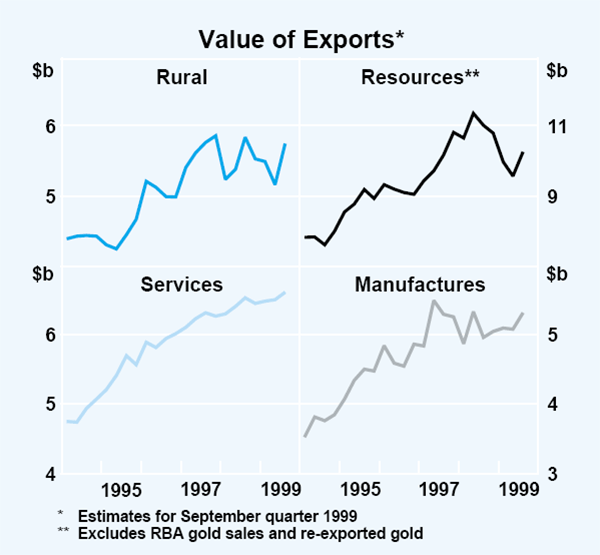
Resource exports to most destinations increased in the quarter, but somewhat surprisingly given the rebound in their economies, exports to the initial crisis-affected economies fell and remain 5 per cent lower than a year ago. Looking forward, the outlook for resource exports is more favourable than it has been in the past couple of years. It is likely that growth in sales to the Asian region will increase as businesses in those countries meet further increases in demand by boosting production rather than running down stocks. The commencement of production at a number of large resource projects over the next two years should also provide a significant boost to exports of base metals and oil.
Manufacturing export revenues increased by around 4¾ per cent in the quarter, and are currently around 7¼ per cent higher than a year ago reflecting solid growth in volumes to most destinations. Manufactured exports to the initial crisis-affected economies have risen by around 24 per cent from the trough in the September quarter 1998, while those to New Zealand – which account for around 20 per cent of the total – have also grown strongly. Exports to other east Asian countries have fallen by over 10 per cent over the past year, reflecting the economic difficulties in some of those countries in the early part of that period.
The value of rural exports increased strongly in the September quarter, with exports to Japan and other markets accounting for most of the gain. There was stronger growth in exports of most rural commodities. As was the case in the March and June quarters, wool growers have continued to take advantage of relatively favourable prices by exporting from their stocks. Beef exports also rose strongly, with increased demand from Japan and the US. The outlook for rural exports is mixed. While higher production of wheat, canola and sugar suggests higher export growth over the next year, the slowdown in slaughter rates for beef indicates some softening in meat exports.
Service exports increased modestly in the September quarter and are around 5 per cent higher than a year ago. Travel revenues have increased by around 6½ per cent over this period. The number of short-term arrivals has now fully recovered from the fall resulting from the Asian crisis, although the composition has changed (Graph 26). The share of arrivals from Europe and the US has increased significantly at the expense of arrivals from Asia. Arrivals from the initial crisis economies have recovered somewhat, but are still well below their levels prior to the crisis. Tourist arrivals from Japan have been on a downward trend since early 1998.
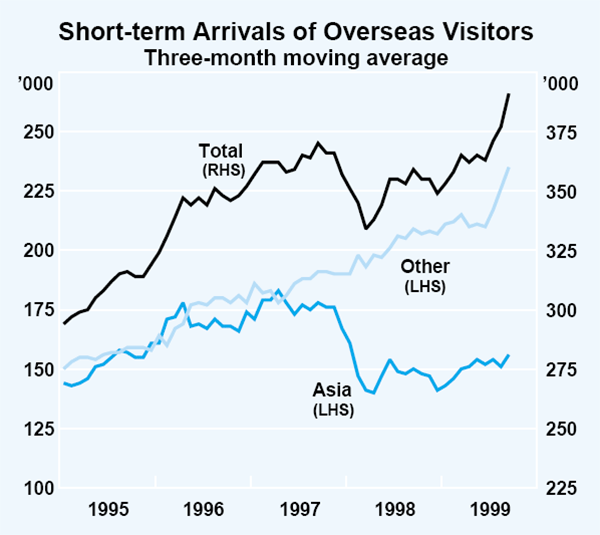
Following declines over the past three quarters, driven by significant price falls, expenditure on imports of goods and services rose by 6 per cent in the September quarter, to be 3½ per cent higher than a year ago. A large part of the rise in the September quarter reflected the impact of higher oil prices and the importation of a number of lumpy capital imports, including some civil aircraft and defence equipment.
In underlying terms, imports increased by around 2 per cent in the September quarter, with services and consumption goods imports accounting for most of the growth. There was a significant fall in telecommunications imports, which had grown by 70 per cent in the first two quarters, reflecting the purchase of communication cables for the worldwide upgrade of the cable network and the upgrade of the domestic network for the carriage of the Olympics. Mobile telephone imports have also risen strongly in 1999 as the deadline nears for the conversion from analogue to digital technology. Abstracting from these special factors, underlying import volumes have grown very strongly over the past year, reflecting the strength of domestic demand and significant falls in imported goods prices.
The current account deficit widened to 6.2 per cent of GDP in the June quarter as export values fell more than imports (Graph 27). The monthly trade data suggest that the trade component of the deficit widened slightly in the September quarter. Assuming the net income deficit remained unchanged, this would imply little change in the current account deficit as a proportion of GDP in the September quarter.
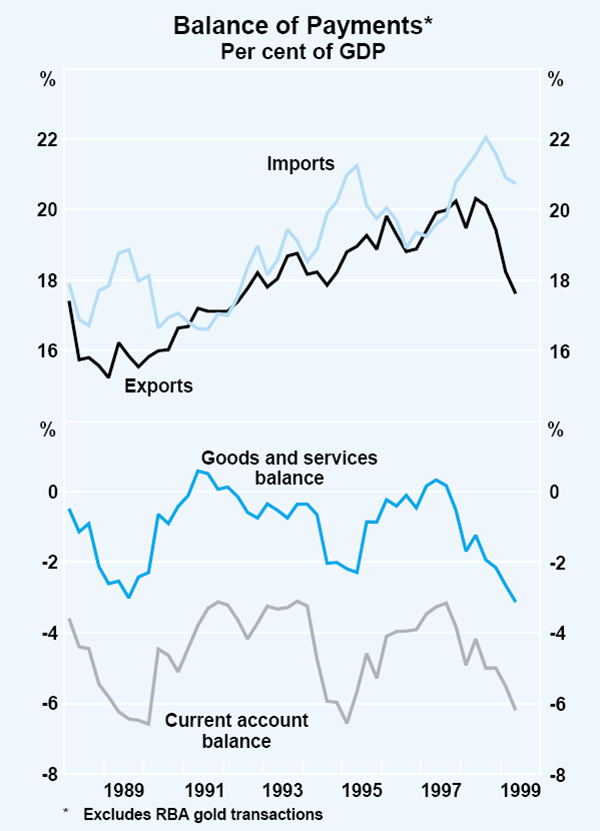
Net foreign debt liabilities fell by $6 billion in the June quarter – mainly a result of the appreciation of the exchange rate over the quarter – reducing the ratio of net foreign debt to GDP to 38.3 per cent. Interest and dividend payments both increased in the June quarter. The ratio of net income payments to exports increased to 15.7 per cent in the June quarter, from 15.0 per cent in the March quarter, but remains relatively low in historical terms.
Commodity prices
In aggregate, commodity prices were little changed in the September quarter in SDR terms (Graph 28). There were increases in the prices of base metals and rural commodities of around 10 per cent and 2½ per cent, respectively, which were offset by falls in the prices of gold and coal.
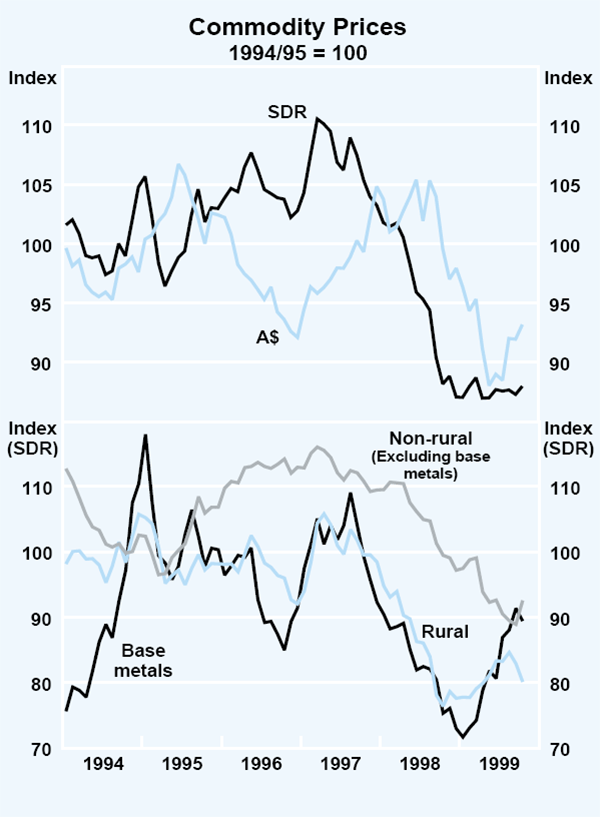
The recent announcement by European central banks to restrict further sales of gold and the decision by the IMF to fund its debt-relief initiative with off-market transactions, contributed to a sharp recovery in sentiment in the gold market in late September; the gold price in US dollars increased by around 25 per cent in the wake of these decisions, but has since retraced about half of this rise. (See Box B for details.)
The price of crude oil (which is not included in the RBA commodity price index) has almost doubled since February (see Box D in the chapter on ‘Inflation Trends and Prospects’). Base metal prices are now over 20 per cent higher than at the beginning of the year. This reflects ongoing cutbacks in production by high-cost producers and also the improvement in the outlook for world economic growth. The one exception is lead, where increased production in China has resulted in a substantial build-up in stocks, thereby limiting the price rise.
Significant increases in the prices for beef (9 per cent) and sugar (8 per cent) accounted for the rise in rural commodity prices in the September quarter. The rise in beef prices was driven by the recovery in Asian demand and herd rebuilding in Australia, which more than counterbalanced the expectation of large US supplies of beef over the remainder of 1999. The recovery in the sugar price follows its fall of around 50 per cent since late 1997. The medium-term outlook for sugar remains subdued with substantial stocks yet to be run down.
Box B: Recent Developments in the Gold Market
The past year has seen large movements in the price of gold, falling to 20-year lows in the September quarter – following the commencement of a series of gold auctions by the Bank of England and discussions concerning the possible sale of gold by the IMF – and then rebounding to its late 1997 level, following the announcements by European central banks of a moratorium on further gold sales and loans, and by the IMF of an alternative plan to revalue its gold holdings without sales on the open market. At present, the price is a little over US$290 per ounce, about 15 per cent above the recent low point but about 30 per cent below the most recent peak of US$415 per ounce (Graph B1).
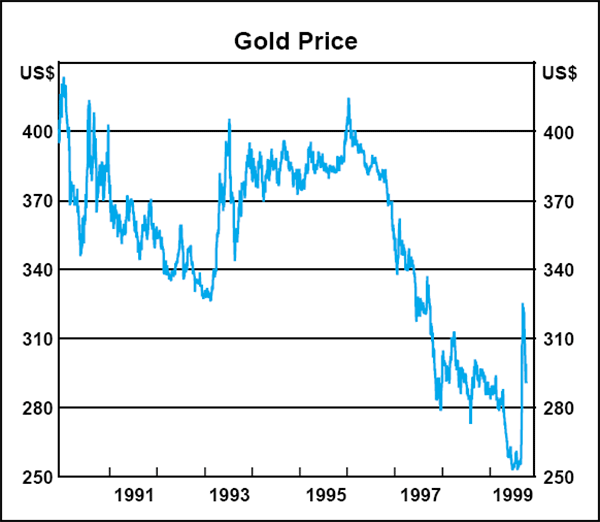
The sharp fall in the gold price over 1997 and 1998 seemed to reflect market concerns about possible official sector sales more than the sales themselves. During this period, the amount of gold sold by central banks was broadly in line with earlier years. There was, however, an increasingly prevalent practice of central banks making their gold holdings available for lending. As can be seen in Graph B2, since 1996 gold lending by central banks increased by a little over 1,000 tonnes to about 4,300 tonnes. Gold lending effectively facilitates additional activity by other market players, including producer hedging activity and short-selling by speculators. The activities of these players have had a significant role in the recent volatility of gold prices.
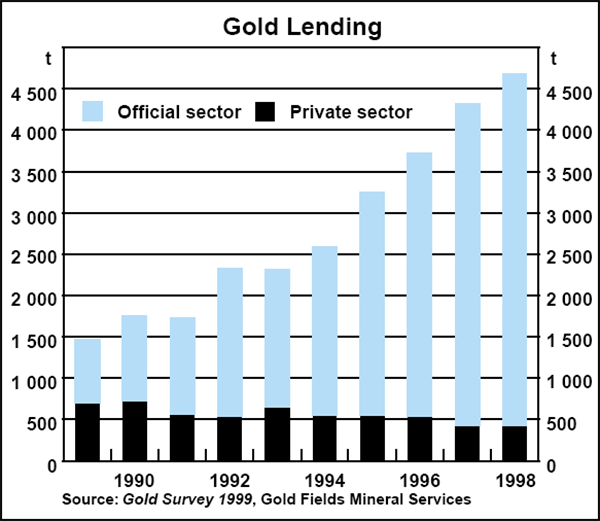
Gold producers often seek to protect themselves against variation in their earnings by hedging future production. This can be done through forward transactions or options, but either way the result is that the gold supply is effectively brought forward through a sale by the counterparty to the forward/option contract. This is because the counterparty to the producers' transactions will need to cover their position in the market, which is typically done by borrowing gold (usually from central banks) and selling it into the market. According to industry sources, producer hedging and the use of gold loans are estimated to have resulted in about 750 tonnes of accelerated supply to the gold market since the start of 1996.
Over the past couple of years, speculators have also used short sales of gold to obtain low cost funds to invest in other assets – for example, by shorting gold (borrowing it and selling it in the spot market), market participants have been able to obtain US dollars at between 1 and 2 per cent, well below the rate of return available on US assets. Selling gold short has therefore been an alternative to the ‘yen-carry’ trade which saw market participants fund investments in various markets by borrowing yen (at almost zero cost due to the low interest rates in Japan) and selling it for other currencies, mostly US dollars. Although short-sellers ran the risk of a rise in the gold price, this risk had been judged to be low in a climate of generally negative sentiment towards gold.
Much of this activity takes place in over-the-counter markets, rather than on exchanges, so figures are difficult to come by. The only indication of the scale of speculative short-selling on these markets comes from statistics on the gold lending market, which short-sellers must use to fund their sales. Since the beginning of 1996, gold loans to speculators are estimated to have increased by about 350 tonnes.
With 25 per cent of all above ground gold stocks held by central banks, any increase in demand for borrowed gold by short-sellers has been easily met by an increase in central bank lending. Whereas in most markets an increase in short-selling puts pressure on the lending market and pushes up the interest rate at which short-sellers can borrow the underlying stock, the ready supply of gold loans from central banks seeking to earn some return on their gold holdings has, until recently, helped to keep lease rates low, generally in the range of 1–2 per cent (Graph B3).
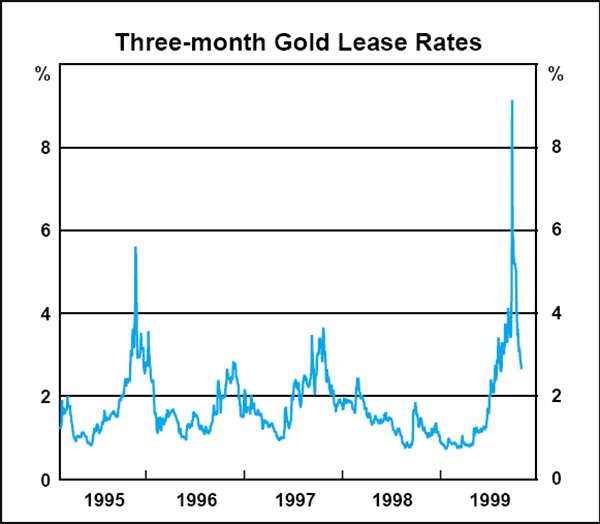
In late September, a group of 15 European central banks (including the Bank of England) announced that:
- They would not sell any gold beyond already decided sales for five years. Such sales were said to be 2,000 tonnes, of which the Bank of England accounts for about 400 tonnes and the Swiss National Bank 1,300 tonnes.
- Sales already decided would be co-ordinated and spread over 5 years so that the amount sold in any one year would not exceed 400 tonnes.
- Gold lending would not be increased.
This caused an important structural change in the gold market. The prospect of reduced central bank sales removed the downward pressure on the gold price, while the proposed cap on gold lending pushed up lease rates. Both factors worked to make the ‘gold-carry’ trade unattractive. As such, the announcement led to extensive buying as speculators rushed to cover short positions. There was also some unwinding of hedges by producers. Lease rates spiked to almost 10 per cent before settling around 2–3 per cent, and the price of gold rose to as high as US$340 per ounce, before falling back under US$300 per ounce.
Domestic Financial Markets
Market interest rates
Short-term market interest rates have increased in recent months, first almost in a mechanical reaction to the tightening of US monetary policy – with markets anticipating that Australia would quickly follow its lead – and then as the market saw a more general case emerging for a tightening of monetary policy in Australia. The yield on 90-day bank bills had risen to 5.40 per cent in early November, 0.65 of a percentage point above the previous cash rate target of 4.75 per cent. With the tightening of monetary policy involving a rise in the cash rate of 0.25 of a percentage point, there was little further increase in bill yields. The yield on 180-day bills was 5.60 per cent (Graph 29).
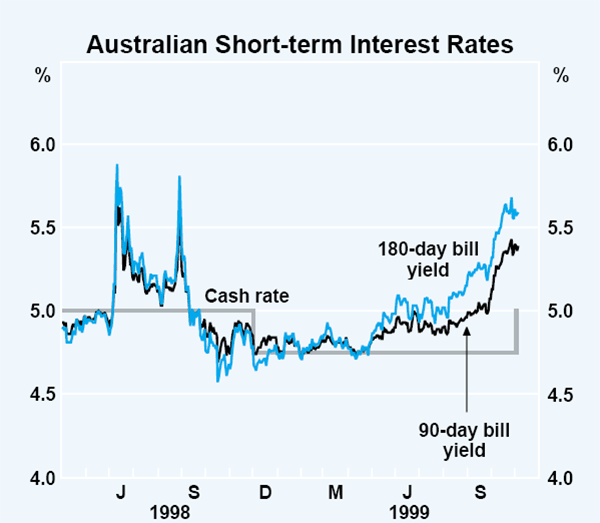
In addition to expectations about monetary policy, liquidity concerns of banks related to Y2K may have influenced the pattern of short-term interest rates in recent months. In most countries, a ‘spike’ has been evident for much of 1999 in expectations about the level of interest rates around the turn of the year. The ‘spike’ in expectations about Australian short-term interest rates is relatively small compared with those evident in other countries, reflecting a high degree of confidence among banks in Australia that liquidity needs have been well provided for.
As in other countries, bond yields in Australia have moved up in line with the changing world economic and inflation outlook. The yield on 10-year bonds was 6.60 per cent in early November, a rise of 1.1 percentage points over the past six months (Graph 30). This is a little larger rise than the move in US bond yields in the same period, resulting in a small widening in the spread to US bonds. Since early August, this spread has averaged about 0.5 of a percentage point, compared with an average of about 0.3 of a percentage point earlier in 1999 (Graph 31). The recent widening of this spread is, of course, much smaller than was seen in 1994 in the previous episode of globally rising bond yields, when the yield on 10-year bonds in Australia moved from 1 percentage point to about 3 percentage points above the comparable US yield. A number of factors have contributed to this better performance, including a notably stronger fiscal position, as well as greater confidence that monetary policy in Australia will be set to maintain a low rate of inflation.
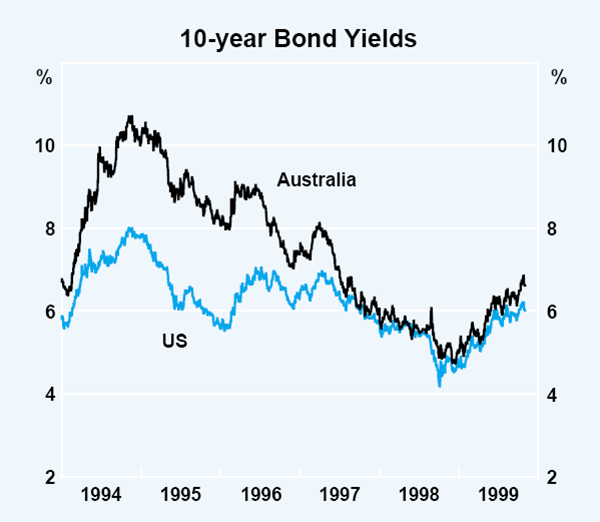
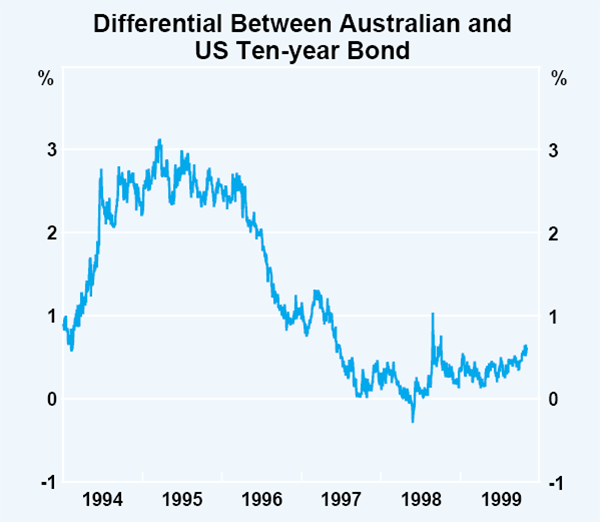
Issuance of non-government bonds has been strong in 1999, with gross new issues of $24 billion in 1999 to date, compared with about $10 billion in the same period of 1998. In the year to October, the level of non-government bonds outstanding rose by around 50 per cent. As in other countries, credit spreads on non-government paper tended to widen in Australia in the middle months of 1999; the spread on high-grade corporate paper above Commonwealth Government securities roughly doubled to 0.7 of a percentage point. While strong fundamental factors are driving recent growth in the non-government bond market, some commentators have ascribed the timing of some issues to borrowers ‘getting in’ ahead of Y2K, behaviour which would also have contributed to rising spreads. The more recent narrowing of credit spreads might also be consistent with concerns about Y2K abating in financial markets, as participants have become more confident about their preparations (Graph 32).
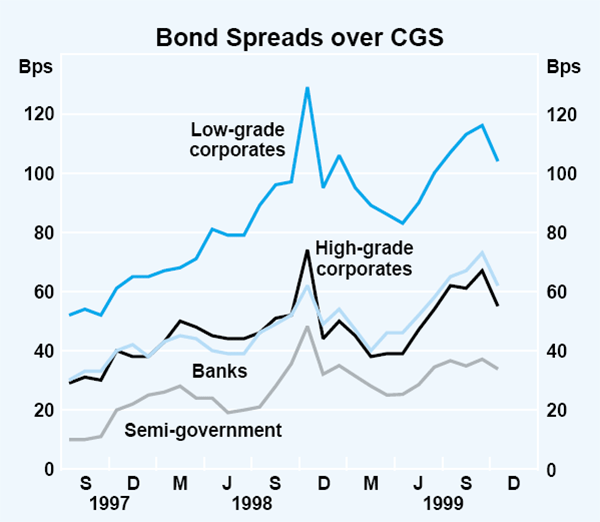
Intermediaries' interest rates
The rise in short-term market interest rates ahead of the move in monetary policy had very limited effect on the interest rates that intermediaries charge for variable-rate loans, notwithstanding the fact that the marginal cost of banks' funding of such loans is related to bill yields. As this document was printed, intermediaries had not announced any changes in lending or deposit rates following the increase in the cash rate in early November.
There were some minor adjustments to standard variable housing loan rates in the September quarter, when four banks raised their rates by up to 10 basis points to 6.55 per cent, bringing them into line with those of major competitors (Graph 33). At the same time, some banks introduced a new product with a ‘honeymoon’ rate of less than 5.0 per cent for six months. The average ‘honeymoon’ rate, available for twelve months, increased by 45 basis points to 5.75 per cent.
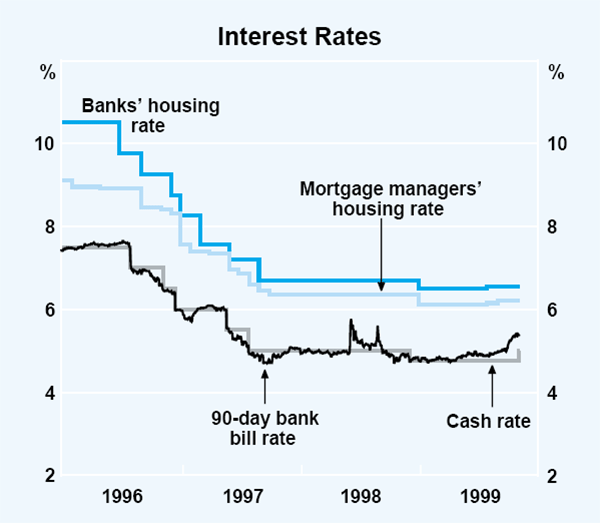
Some mortgage managers raised their variable housing loan rate by 5–15 basis points, but these were still below those offered by banks. Generally, mortgage managers have absorbed much of the increase in bill yields into reduced interest margins even though they rely almost exclusively on funding in capital markets. This response reflects the ongoing competitive environment in the market for housing finance. Mortgage managers' share of housing loan approvals has recently tended to rise again, at the expense of banks.
Indicator rates on variable-rate business loans have been largely unchanged over the past six months, although the average interest rate paid by small business borrowers on variable-rate loans – which includes indicator rates plus applicable risk margins – has continued to fall. In the June quarter (the latest data available), the average interest rate paid by small businesses on variable-rate loans was 8.4 per cent. In the phase of easing of monetary policy which began in mid 1996, the average interest rate paid by small business fell by 4.2 percentage points, about 1½ percentage points more than the reduction in the cash rate. The contraction in this margin partly reflected the growing popularity of loans secured by residential property, which have a lower indicator rate than other loans and in most cases no additional risk margin. Competition in this market continues to intensify. One bank has introduced a small business loan secured by commercial property, reducing the interest rate at which such a loan would previously have been available from this bank, while another introduced a ‘basic’ residentially secured term loan for small business at 6.35 per cent, 40 basis points lower than that bank's standard residentially secured term loan.
In the case of fixed-rate loans, there have been some more noticeable rises in interest rates charged by banks, in line with rises in yields in capital markets. On three-year loans, interest rates rose by 0.75 of a percentage point over the past six months, to 7.5 per cent for housing loans and 8.0 per cent for small businesses.
Interest rates of intermediaries in Australia remain historically low, both in real and nominal terms, and by international standards (Table 7). Intermediaries' interest rates, both for the household and business sectors, are, for example, well below their previous cyclical lows. While the cash rate had been at the same level as at the previous low in 1993/94 prior to the move in monetary policy, intermediaries' rates were between 1 and 3½ percentage points lower both in nominal and real terms. These moves down were due to greater competition among intermediaries. In other English-speaking countries, interest rates that intermediaries currently charge businesses are generally higher than at their previous cyclical low point for the decade.
| Nominal rates | Real rates(b) | ||||||
|---|---|---|---|---|---|---|---|
| End-Oct | Trough of 1993/94 | Difference | End-Oct | Trough of 1993/94 | Difference | ||
| Australia | |||||||
| Cash rate | 4.75 | 4.75 | 0 | 2.6 | 2.6 | 0 | |
| Housing | 6.55 | 8.75 | −2.20 | 4.3 | 6.5 | −2.2 | |
| Personal | 6.65 | 9.75 | −3.10 | 4.4 | 7.5 | −3.1 | |
| Large business | 7.95 | 9.00 | −1.05 | 5.7 | 6.8 | −1.1 | |
| Small business | 7.45 | 9.30 | −1.85 | 5.2 | 7.1 | −1.9 | |
| Average business | 8.10 | 10.50 | −2.40 | 5.8 | 8.2 | −2.4 | |
| United States | |||||||
| Cash rate | 5.25 | 3.00 | 2.25 | 3.3 | −0.5 | 3.8 | |
| Housing | 7.80 | 7.00 | 0.80 | 5.8 | 3.8 | 2.0 | |
| Business | 8.30 | 6.00 | 2.30 | 6.2 | 2.5 | 3.7 | |
| Canada | |||||||
| Cash rate | 4.50 | 3.60 | 0.90 | 2.6 | 2.1 | 0.5 | |
| Housing | 7.05 | 5.75 | 1.30 | 5.2 | 4.3 | 0.9 | |
| Business | 6.25 | 5.50 | 0.75 | 4.4 | 3.6 | 0.8 | |
| United Kingdom | |||||||
| Cash Rate | 5.25 | 5.25 | 0 | 3.2 | 2.5 | 0.7 | |
| Housing | 6.60 | 7.70 | −1.10 | 4.5 | 4.9 | −0.4 | |
| Business | 6.25 | 6.25 | 0 | 4.2 | 3.8 | 0.4 | |
| New Zealand | |||||||
| Cash Rate | 4.50 | 5.00 | −0.50 | 3.4 | 3.4 | 0 | |
| Housing | 6.50 | 7.40 | −0.90 | 5.4 | 6.2 | −0.8 | |
| Business | 8.50 | 9.10 | −0.60 | 7.3 | 7.6 | −0.3 | |
| (a) Except in the case of the average business interest rate in Australia,
all business loan rates are indicator rates. (b) Measured using underlying inflation. |
|||||||
Share market
As in the United States, the strong rise in share prices in Australia came to a halt in April. Since then, the All Ordinaries Index has fallen by 7 per cent, a movement broadly similar to that in the US share market. For a time, share prices in Australia had performed more strongly than those in the US market due to the strength in prices of resource stocks (excluding gold producers), in anticipation of stronger industrial production globally and rising commodity prices (Graph 34). Since mid year, however, the prices of these stocks have tended to decline, capping the earlier upward momentum of the market generally. The price of stocks of gold producers fluctuated with the price of gold itself, first falling sharply, then rebounding on news of the plan of the European central banks to limit sales of gold, before giving up some of these gains as markets re-assessed the importance of this announcement. The price indices of shares of banks and other industrials are both down by about 10 per cent from their peak.
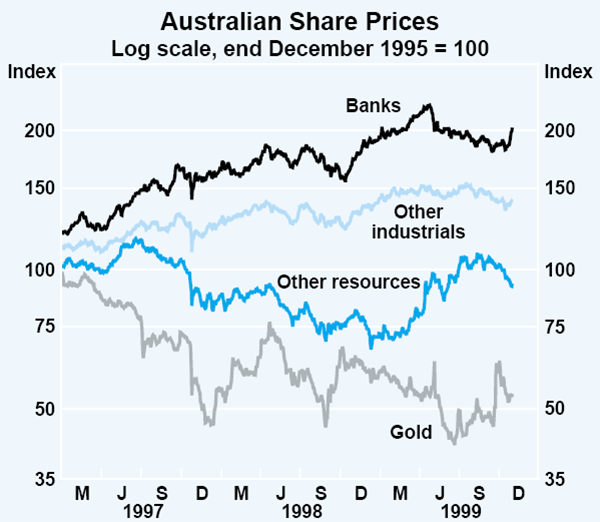
The market absorbed the sale of an additional 16.6 per cent of Telstra quite comfortably, with strong demand by households. The proportion of Australian adults now owning shares directly has reached a similar level to that in the US.
Australian dollar
After rising from its late 1998 lows around US55 cents, the Australian dollar has been broadly steady since April 1999 in a range of US63½ to US67 cents (Graph 35). Early in the period, talk of a bottoming in commodity prices and a more optimistic tone in world markets generally saw the currency rise to around the top end of this range on several occasions. This factor has continued to be supportive for the currency more recently, as has the sharp rise in the price of gold (see Box B in the previous chapter). But the tightening of US monetary policy (with the consequential negative impact on Australia's short-term interest differential) and the strengthening of the yen have worked in the opposite direction. In particular, the Australian dollar fell to around US63 cents by late August as investors moved out of the currency into the rapidly appreciating yen; the bilateral rate against the yen fell from 82 to 70 yen over the same period.
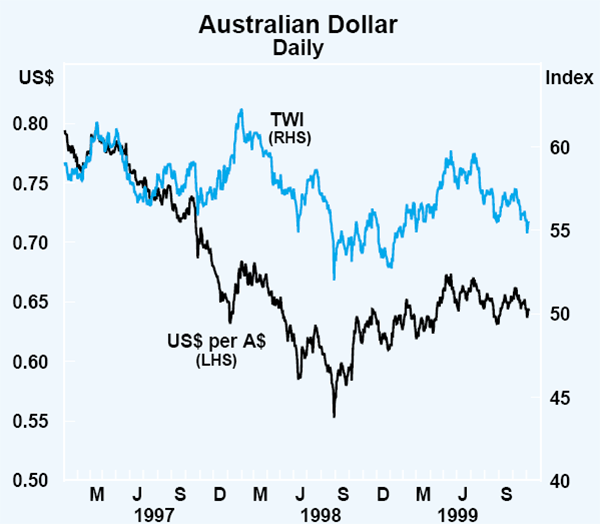
While the exchange rate against the US dollar has been on a flat trend recently, the trade-weighted index has shown a significant decline (8 per cent) since its July peak of 59.7. This reflects the fact that the US dollar has generally been weakening against other major currencies during this period, most noticeably against the yen.
With the exchange market stable, the Bank in its foreign exchange operations has followed its normal practice of covering the Commonwealth Government's foreign exchange needs in the market. Over the past six months, it has sold $2.5 billion of foreign exchange to the Commonwealth and bought a broadly similar amount in the market. There has, therefore, been little net change in net holdings of foreign exchange reserves, apart from valuation effects arising from exchange rate changes.
The gross level of reserves, however, has risen substantially over this period, from $24 billion to $30 billion, due to the use of foreign exchange swaps to manage domestic liquidity (see Box C). This rise in reserves has been matched by a corresponding rise in the Bank's forward commitments to sell foreign exchange.
Financial aggregates
Credit growth slowed a little in recent months to an annual rate of 10 per cent in the six months to September (Graph 36). Within the total, there has been a change in the mix of total credit growth between households and businesses. Credit provided to households has been accelerating through 1999, reaching an annual growth rate above 15 per cent over the six months to September (Table 8). In contrast, intermediated business borrowing has slowed, although, as noted in the section on the business sector, business funding from other sources continues at a strong pace.
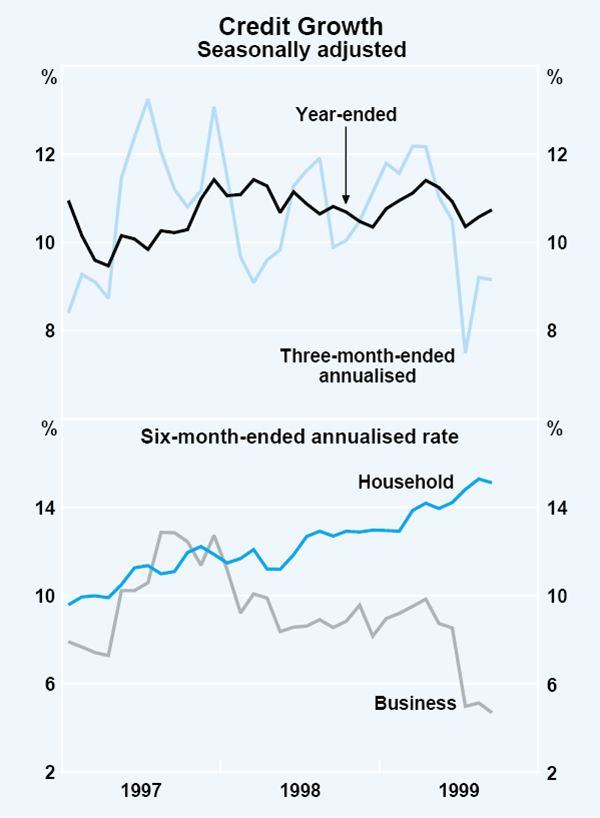
| Year to September 1999 |
Three months to: | ||
|---|---|---|---|
| June 1999 | September 1999 | ||
| Total credit | 10.7 | 10.5 | 9.2 |
| – Personal | 17.6 | 11.4 | 21.4 |
| – Housing | 13.6 | 14.2 | 15.4 |
| – Business | 7.1 | 7.5 | 2.0 |
| Currency | 7.1 | 8.0 | 6.1 |
| M1 | 8.2 | 8.2 | 9.9 |
| M3 | 8.9 | 16.1 | 6.5 |
| Broad money | 8.3 | 15.1 | 4.9 |
Currency growth picked up towards the middle of the year before moderating a little in recent months. With annual growth at around 7 per cent, currency continues to increase faster than nominal household income and around the same rate as retail sales. Growth in the broader money aggregates also picked up in the middle of the year, but has subsequently slowed, reflecting fluctuations in the growth of corporate holdings of certificates of deposit. Fixed bank deposits have been fairly flat in recent months. Broad money and M3 grew at annual rates of 9.8 per cent and 11.2 per cent over the six months to September.
Funds under management increased by around 3 per cent in both the March and June quarters. Annual growth is well down from the peaks seen in 1997/98, but it is still much stronger than growth in household disposable income or bank fixed deposits. Net inflows of new funds have driven much of the growth in recent quarters, while valuation effects have been relatively less important of late, reflecting weaker share prices in Australia and overseas. Within the total managed funds sector, funds flowing into cash management trusts have been slowing in recent quarters and were flat in the June quarter. By contrast, net inflows were strongest into public unit trusts. Managed funds increased their exposure to cash and short-term securities and reduced their exposure to domestic equities and holdings of foreign assets in the June quarter, resulting in a more liquid portfolio overall.
Box C: The Reserve Bank's Market Operations and Telstra 2[1]
The payments associated with the privatisation of a further 16.6 per cent of Telstra had a substantial impact on flows of liquidity in the money market in October, and therefore were an important consideration in the Bank's market operations.
As retail and institutional investors paid for the first instalment of their subscriptions, $9.6 billion was withdrawn from the money market as banks transferred the funds to the Commonwealth's account at the Reserve Bank. There were three groups of flows (see Graph C1):
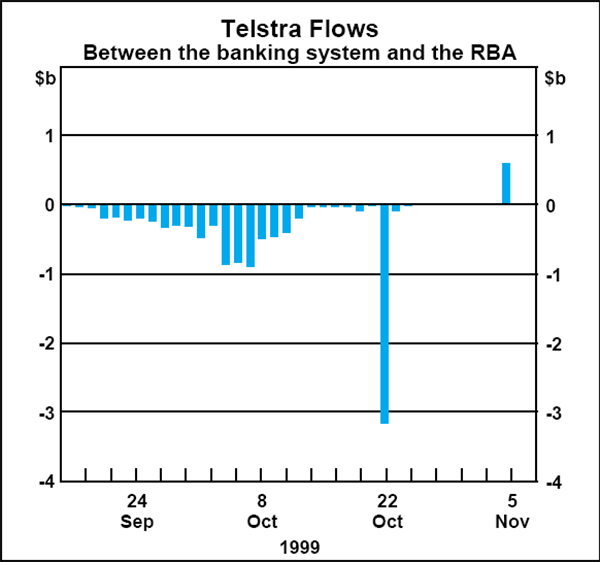
- proceeds of $7.0 billion from domestic retail applicants, spread out from late September to mid October;
- proceeds of $3.2 billion from successful institutional bidders concentrated on 22 October; and
- refunds of $0.6 billion of oversubscriptions to domestic retail applicants in the week commencing 1 November; payment of refunds had the effect of returning liquidity to the banking system.
Through this period other influences added about $2 billion, in net terms, to money market liquidity, so that overall, in the period in which Telstra 2 was settled, there was a drain of about $7.6 billion of liquidity from the market. These influences are summarised in Table C1.
| Net impact on liquidity | |||||
|---|---|---|---|---|---|
| Telstra 2 | −9.6 | ||||
| Other transactions(b) | 2.0 | ||||
| −7.6 | |||||
| Reserve Bank operations | |||||
| Net repurchase agreements | 1.6 | ||||
| Net foreign exchange swaps | 5.0 | ||||
| Outright purchases of CGS | 1.0 | ||||
| Change in system liquidity | 0 | ||||
| (a) A negative sign implies a withdrawal of liquidity. (b) Including government payments and tax receipts, settlement of new issues of Commonwealth Government securities (CGS) and payment of dividends by Telstra. |
|||||
Such large aggregate flows through the system required commensurately large offsetting operations by the Reserve Bank to maintain system liquidity.
In providing this liquidity, the Bank relied to a greater degree than usual on foreign exchange swaps to supplement outright transactions in CGS and repurchase agreements (repos). Foreign exchange swaps are similar to repurchase agreements, except they involve the exchange of cash for foreign currency rather than securities. Under the swaps in question, the first leg involved the Bank exchanging Australian dollars for foreign currency (thereby adding to the supply of Australian dollars in the money market) with the transactions to be reversed in the second leg, which in most cases is scheduled for the first quarter of 2000 (though some swaps may, of course, be rolled forward).
After allowing for operations to shift funds within the period, the Bank accommodated the net outflow by undertaking an additional $1.6 billion of repos (increasing its repo book to about $7 billion) and $5 billion in foreign exchange swaps. The remainder was undertaken through outright purchases of CGS.
The increased use of foreign exchange swaps has lifted the Bank's outstanding forward foreign exchange commitments to about $16 billion. This rise was matched by a counterpart rise in the Bank's holdings of foreign assets, and therefore had no effect on the Reserve Bank's net foreign reserves position.
The Bank has used foreign exchange swaps to manage domestic liquidity at various times in the past, though their use on this occasion was heavier than usual, for two reasons. First, as the Government has been running budget surpluses, the stock of CGS outstanding has fallen. Exclusive reliance on transactions in CGS – either as outright purchases or via repos – to provide liquidity on the scale required for settlement of Telstra 2 could have caused distortions in the CGS market itself or in the repo market. Second, the Bank is also aware that preparations for Y2K could see banks' demand for liquidity rise, perhaps substantially. In that context, the relative reliance on foreign exchange swaps to manage the liquidity implications of Telstra 2 leaves a larger pool of CGS available to banks to manage their liquidity as Y2K approaches. This will also provide greater operational flexibility to the Reserve Bank through this period. It is possible also that the Bank will continue to rely to a greater extent than normal on foreign exchange swaps to provide system liquidity ahead of Y2K.
Inflation Trends and Prospects
Recent developments in inflation
Consumer prices
Inflation remains low, but it has increased a little. The Consumer Price Index (CPI) increased by 0.9 per cent in the September quarter, up from 0.4 per cent in the June quarter (Graph 37). The year-ended inflation rate rose to 1.7 per cent, or 2.2 per cent abstracting from the estimated effect of the health insurance rebate which reduced the March quarter CPI.
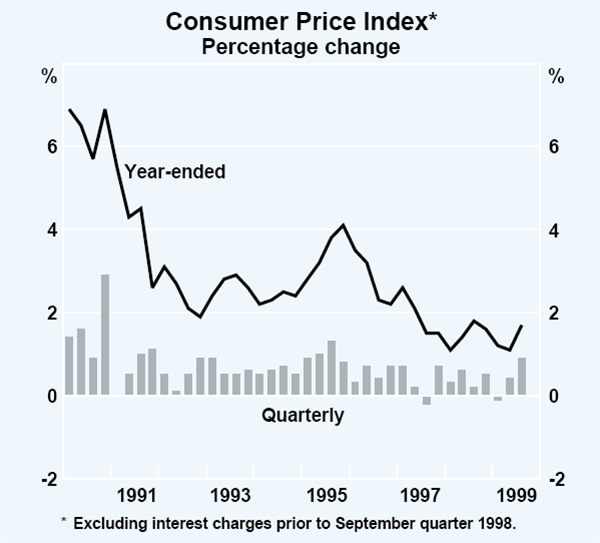
Increases in petrol prices made a substantial contribution to the rise in the CPI in the September quarter. Petrol prices increased by 8.8 per cent in the quarter and contributed 0.35 percentage points to the increase in the CPI, following a smaller increase in the June quarter. The rise in petrol prices reflects the worldwide increase in crude oil prices since March, which reverses the decline in oil prices that had acted to reduce the CPI in earlier quarters (see Box D).
It is not only petrol prices, however, which have contributed to slightly higher inflation. Various measures of underlying inflation, which typically exclude the rise in the price of petrol, also picked up, to rates of 0.6 to 0.8 per cent. These measures suggest that prices increased by around 2 per cent over the past year, a little higher than the inflation rates seen during 1997 or 1998 (Table 9). This pick-up was spread across many components, significant among which were house purchase costs and motor vehicle prices. House purchase costs increased by 2.0 per cent in the quarter and by 5.5 per cent over the year. These prices continue to rise more rapidly than building-materials prices, suggesting that profit margins and/or labour costs in the residential construction sector have increased in response to the recent strength in demand for residential construction work and the rise in prices of established houses.
| Quarterly | Year ended | ||||
|---|---|---|---|---|---|
| June 1999 |
September 1999 |
June 1999 |
September 1999 |
||
| Headline CPI | 0.4 | 0.9 | 1.1 | 1.7 | |
| – Tradeable component | 0.8 | 0.7 | 1.0 | 1.6 | |
| – Non-tradeable component | 0.2 | 1.1 | 1.2 | 1.8 | |
| Private-sector goods and services | 0.4 | 0.6 | 1.6 | 2.0 | |
| Weighted median price change(a) | 0.5 | 0.7 | 1.9 | 2.1 | |
| Trimmed mean price change(a) | 0.4 | 0.8 | 1.4 | 1.9 | |
| (a) For details on the calculation of these measures, see ‘Measuring Underlying Inflation’, Reserve Bank of Australia Bulletin, August 1994. | |||||
Motor vehicle prices rose by 0.7 per cent in the quarter, the first increase for six quarters. Over recent years, motor vehicle prices have fallen substantially, and have acted to reduce both the CPI and underlying measures of inflation quite noticeably. These declines were led by prices of imported motor vehicles, which fell by more than 20 per cent between late 1995 and June 1999. Imported car prices rose by 2.5 per cent in the September quarter 1999, possibly reflecting some rebuilding of wholesalers' and retailers' profit margins. While the latest data show that imported motor vehicle prices have increased, weakness in demand in the run-up to the tax changes next year may place some restraint on motor vehicle dealers' ability to raise prices in the near term.
General measures of domestically sourced inflation picked up in the September quarter. Non-tradeable prices, a new category published by the ABS with the September quarter CPI, rose by 1.1 per cent in the quarter, partly reflecting the higher house purchase costs noted above. Private-sector services prices also increased by 1.1 per cent in the quarter and by more than 3 per cent over the year (Graph 38). Tradeable prices other than petrol were unchanged in the quarter.
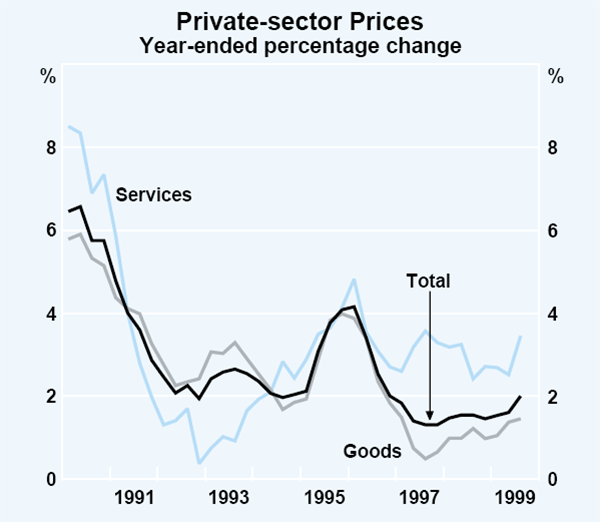
Producer prices
Producer prices in the manufacturing and construction sectors also show some pick-up. Final prices of manufactured goods increased by 2.0 per cent in the September quarter. The increase in oil prices contributed more than half of this rise, but there were also some significant price increases recorded for other parts of the manufacturing sector. Excluding petroleum and coal products, final manufacturing goods prices increased by 0.9 per cent, the largest quarterly increase in more than four years (Table 10). In part, this rise reflected higher prices for basic metal products, resulting from developments in world commodity markets. With the exception of petroleum, the prices of inputs used by the manufacturing industry remained subdued in the September quarter. The Australian dollar price of many imported inputs fell in the quarter, in a lagged response to the exchange rate appreciation earlier in the year.
| September Quarter 1999 |
Year to September 1999 |
|
|---|---|---|
| Manufacturing | ||
| Input prices | 2.1 | 0.7 |
| – Domestic | 3.7 | 4.0 |
| – Imported | −0.1 | −3.8 |
| Final prices | 2.0 | 1.0 |
| – Excluding petroleum | 0.9 | −0.1 |
| Construction | ||
| Materials used in house building | 1.1 | 0.9 |
| Materials used in other building | −0.2 | 0.3 |
| Merchandise trade | ||
| Export prices | 1.0 | −10.3 |
| Import prices | −0.1 | −5.8 |
The prices of materials used in house building increased sharply in the September quarter, particularly in Sydney and Melbourne. This is consistent with strong demand for house-building materials associated with the recent pick-up in activity in the housing market, as discussed in the chapter on ‘Domestic Economic Activity’. The prices of other building materials remain weak.
The exchange rate and inflation
Between late 1998 and the middle of 1999, the Australian dollar appreciated by around 6 per cent, both in import-weighted terms and against the major currencies, retracing around half of the earlier depreciation. It has subsequently depreciated by around 2 per cent from its June quarter average level, but remains well above the level of late 1998. The prices of imported goods and services, recorded ‘at the docks’, have moved broadly in line with the rise in the exchange rate (with a slight lag), falling by about 6 per cent (excluding petroleum) between the December quarter 1998 and the September quarter 1999.
Assessments of the extent to which these price falls will be passed on to consumers at the retail level will need to take account of the unusual behaviour of import prices at the retail level in recent years. As noted in the Bank's August report, the recorded rise in import prices at the docks during 1997 and 1998 was not widely reflected in higher prices for imported items at the retail level. Rather, it appears that margins were compressed. If producers use the recent higher average level of the exchange rate to help restore those margins, then falls in prices at the retail level may not occur to the extent that would usually be expected.
Labour costs
Wages growth has remained moderate in recent quarters, and thus far provides little evidence of any increased pressures despite the stronger labour market conditions over the past year. The Wage Cost Index (WCI), excluding bonuses, recorded an average increase in wage rates of 0.6 per cent in the June quarter and 3.2 per cent over the year to June quarter 1999 (Table 11). This rate of increase has shown little change during the past year. Aggregate wages growth continues to be stronger in the public sector than the private sector, although the difference has narrowed. The WCI for the public sector increased by 3.9 per cent over the year to the June quarter, compared with an increase of 2.9 per cent for the private sector. In part, this difference reflects the higher proportion of public-sector employees covered by enterprise agreements, as enterprise agreements have generally been yielding higher wage outcomes than other wage-setting streams.
| March 1999 | June 1999 | September 1999 | Year to latest |
|
|---|---|---|---|---|
| Quarterly | ||||
| Wage Cost Index (total pay, excluding bonuses) |
||||
| Private | 0.7 | 0.6 | .. | 2.9 |
| Public | 1.5 | 0.3 | .. | 3.9 |
| Total | 0.9 | 0.6 | .. | 3.2 |
| AWOTE | ||||
| Private | 0.0 | 1.6 | .. | 3.2 |
| Public | 1.3 | 0.0 | .. | 4.7 |
| Total | 0.2 | 1.0 | 0.5 | 2.3 |
| AWE | 0.0 | 1.3 | −0.4 | 0.9 |
| Annualised | ||||
| New federal enterprise agreements | ||||
| Private | 3.9 | 3.8 | .. | |
| Public | 3.5 | 3.5 | .. | |
| Total | 3.8 | 3.6 | .. | |
| Year-ended | ||||
| Executive remuneration(a) | ||||
| Executive base salaries | 4.7 | 4.7 | 4.7 | |
| (a) Mercer Cullen Egan Dell Quarterly Salary Review | ||||
Preliminary data indicate that average weekly ordinary-time earnings (AWOTE) increased by 0.5 per cent over the three months to August 1999 and by 2.3 per cent over the year to August, after increasing at a similar rate to the WCI over the year to May. While the AWOTE figures, at face value, indicate a decline in wages growth, they have been highly volatile over the past couple of years and can be subject to significant revision; the latest quarterly data report a somewhat implausible decline in the level of male ordinary-time earnings and appear to be understating underlying wages growth.
Enterprise agreements, which cover around one-third of employees, continue to yield annualised wage increases in the 3½ to 4 per cent range. The average wage increase from new federal enterprise agreements fell to 3.6 per cent per annum in the June quarter, in part reflecting slightly lower outcomes in new private-sector agreements (Graph 39). The average duration of these agreements has shortened to just over two years. In the past two quarters, replacement agreements in the private sector have been specifying similar wage increases to those provided for by the expiring agreements they replace. This is in contrast to the situation a year ago, when the replacement agreements were consistently specifying relatively lower wage increases. The annual growth in executive salaries has remained constant in recent quarters, at around 4.7 per cent, according to the Mercer Cullen Egan Dell Salary Review.
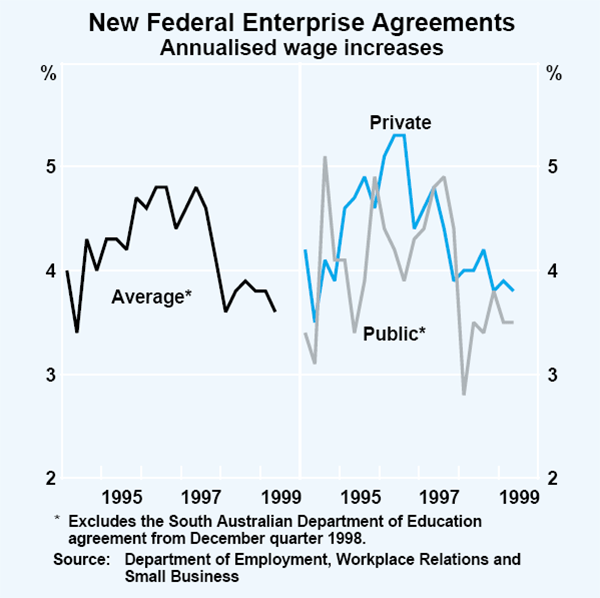
Recent business surveys provide a somewhat mixed picture of the outlook for wages. The September quarter NAB survey finds that labour cost growth picked up to 0.7 per cent in the September quarter, although respondents expect it to return to around 0.5 per cent in the December quarter. The ABS business expectations survey suggests that the 12-month wage outlook remains benign. At the same time, most surveys find that businesses are intending to increase their employment further, and that some businesses are already reporting increased difficulty finding suitable labour, although this does not appear to have been reflected in wage expectations at an aggregate level.
Inflation expectations
Most indicators of inflation expectations have increased in recent quarters, with the increases being more pronounced for consumers and financial market participants. While much of the increase in inflation expectations reflects the anticipated one-time effect on the price level of the introduction of the major components of the Government's tax package in July 2000, part of the increase in these indicators appears to reflect higher expectations of ongoing inflation excluding the GST effect.
Households' inflation expectations over the year ahead, as surveyed by the Melbourne Institute, have shifted up from an average of 3¾ per cent in the second half of 1998 to around 5 per cent in recent months (Graph 40). The expectations of the survey respondents most likely to be involved in price-setting, namely professionals and managers, have shown a larger increase, which occurred mainly around the middle of this year; their inflation expectations increased by around 1½ percentage points between May and July and have since drifted up further to around 5 per cent, the same as the overall average of respondents. These increases appear to be related to the announcement of the tax package and the introduction of the major changes in July 2000. While the average expectation of inflation has clearly increased, the survey also points to a greater degree of uncertainty on the part of consumers as to how the tax package will affect prices in aggregate. There has been a marked increase in the proportion of households expecting inflation to be around 10 per cent, which is the rate at which the GST will be levied but takes no account of the effect of the abolition of some existing indirect taxes. There has also been an increase in the proportion of households expecting prices to fall, which may reflect the publicity attached to the prospect that the prices of some goods will be reduced by these tax changes.
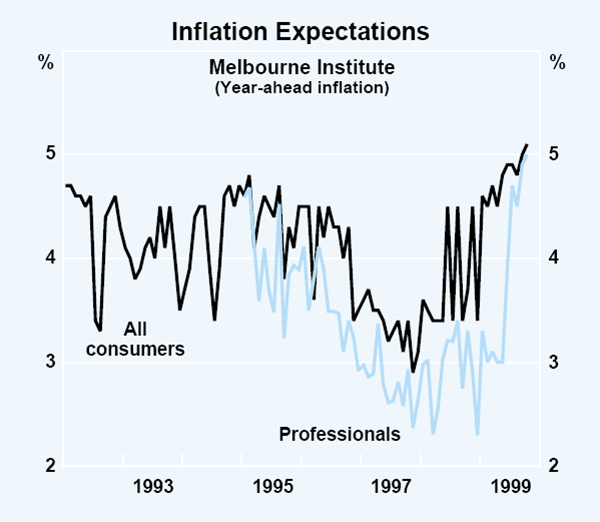
Business surveys continue to indicate that firms are planning only moderate price rises in the near term, although surveys conducted during the September quarter confirm that the downward trend in business price expectations, evident for some years, has now halted. According to the NAB survey, firms expect to increase prices by 0.3 per cent in the December quarter, slightly higher than in the previous quarter. For the first time in a year, the ACCI-Westpac survey of manufacturing firms reported that more firms expect to increase rather than decrease prices in the coming quarter, and for the second consecutive quarter, the ABS Business Expectations survey reports a pick-up in expected price growth. In the NAB survey, medium-term inflation expectations of businesses have also increased slightly.
The inflation forecasts of financial market economists, as surveyed by the Bank, increased following the release of the September quarter CPI (Table 12). The changes to the forecasts for inflation over the years to June 2000 and June 2001 (excluding the effect of the GST) appear to reflect current and prospective developments in oil and tobacco prices as well as a modest increase in the assessment of underlying inflationary pressures. Some financial market economists have also revised up their forecasts of the likely first-year effect of the GST. Medium-term inflation expectations of financial market participants, as implied by the difference between nominal and indexed bond yields, have risen to around 3 per cent in October, from less than 2 per cent at the beginning of the year.
| Year to June 2000 | Year to June 2001 | |||||
|---|---|---|---|---|---|---|
| October 1998 |
July 1999 |
October 1999 |
July 1999 |
October 1999 |
||
| Market economists(a) | ||||||
| CPI | 2.5 | 2.2 | 2.6 | 4.2 | 4.9 | |
| – Excluding GST | 2.2 | 2.4 | ||||
| Union officials(b) | ||||||
| ‘Inflation’ | 2.4 | 2.0 | 2.1 | 2.5 | 3.3 | |
| (a) RBA survey of financial market economists (b) ACIRRT survey of trade union officials |
||||||
Trade union officials, as surveyed by the Australian Centre for Industrial Relations Research and Training (ACIRRT), have raised their inflation forecasts for the year to June 2001. This partially reflects the view held by some respondents of a pick-up in underlying inflation, but it also reflects an increase in the number of respondents who have incorporated an estimate of the first-year effect of the GST into their inflation forecasts.
Inflation outlook
Australia has recorded an exceptionally good combination of strong growth and low inflation in recent years. The important foundations of this performance have been a much-improved trend for productivity, moderate growth in overall labour costs, increased openness to international competition, and the maintenance of low expectations of inflation across the community. For much of the 1990s, the fact that the economy had a good deal of excess capacity has also operated to make these factors more powerful in controlling inflation.
Inflation has, nonetheless, edged higher over the past year or two, with underlying measures having increased from a low of around 1½ per cent in late 1997 to around 2 per cent now. Part of this pick-up, especially in the most recent quarters, is attributable to the effects of strong demand in particular sectors. The most noticeable of these is the housing sector, where strong demand conditions over several years, and the emergence of capacity constraints in some areas, appear to be putting some pressure on prices.
Another part of the story is likely to be that with a stronger world economy, some of the international forces pushing prices down are now starting to weaken. The recent rise in oil prices, itself partly a reflection of stronger global economic conditions, has directly added to CPI inflation in the past two quarters and may have a further contribution through effects on business costs and price expectations. Prices of other commodities traded in international markets have also strengthened since the start of the year, and should continue to be supported by a stronger global economic outlook.
A continuation of these gradual trends appears to be the most likely outcome in the next several quarters. Prospects for global growth continue to be upgraded. Partly as a result of that, Australian economic growth now appears unlikely to decline much further. In fact, it is possible to point to factors that could easily result in an acceleration in output. With the economy now in its ninth year of expansion, having grown strongly for the past three years, the degree of surplus capacity has been declining. This suggests that remaining areas of downward domestic pressure on inflation are likely, at the margin, to weaken.
One area where there is no evidence as yet of increased pressure is wages, despite a noticeable strengthening of the labour market over the past year. The Wage Cost Index continues to record wages growth at an annual rate of around 3¼ per cent, and there has been little change in the wage increases being negotiated under enterprise bargaining, which continue to yield average annualised increases in the 3½ to 4 per cent range. These relatively moderate outcomes have been an important restraining influence on overall inflation during the past year, and they also point to the prospect of continued employment growth and lower unemployment.
Some increase in wages growth might, in due course, be expected in response both to the firmer labour market and the higher recorded price inflation now being observed. The extent of this is an open question, given the changes that have occurred in the labour market in recent years. It is also in this area that expectations of inflation could be important. The imperfect readings recorded in surveys suggest some rise in expected inflation, partly related to the anticipated implementation of the GST in July 2000. The GST will affect inflation only temporarily, however, and effects on wage earners will be offset by income-tax reductions. It is unclear at this stage whether expectations of higher inflation might persist beyond the period of the GST's impact, and to what extent they might serve as a basis for price and wage decisions. This is an area which will require close monitoring over the year ahead.
Overall, the Bank expects some further mild pick-up in recorded inflation over the coming few quarters. The CPI is expected to increase by around 2¾ per cent over the year to June 2000. This figure is a good deal higher than the 1.7 per cent for the latest year-ended rise in the CPI, but the pick-up includes the effect of dropping out the impact of the health insurance rebate, which reduced the CPI in the March quarter 1999, some further effects from past movements in crude oil prices, and an increase in tobacco taxes in the December quarter. Underlying inflation measures are expected to pick up more slowly, to a rate of around 2¼ per cent by mid 2000, and to around 2½ per cent during the following year.
During the 2000/01 financial year, the CPI will of course be affected by the tax package. Because the abolition of some of the indirect taxes will not take effect immediately, the short-term effect of the package on the price level is likely to be larger than the long-run effect. Measured on a year-ended basis, the rate of increase in the CPI will be well above the 2–3 per cent target from the September quarter 2000 to the June quarter 2001. As this results from a once-off tax policy change, the Bank will abstract from this direct effect of the GST for the purposes of assessing inflation outcomes relative to the target. On the assumption that there are no second-round effects of the GST, resulting from stronger wages growth, the year-ended CPI inflation rate is thereafter expected to return to the target zone, as the GST impact drops out of the calculation.
Box D: Oil Prices and Inflation
Oil prices have fluctuated widely in recent years. Since early 1999 the price of crude oil has nearly doubled to over US$20 a barrel, returning oil prices to around their most recent peak, recorded in January 1997 (Graph D1). This sharp increase is around the same size as the increase that occurred in 1990, as a result of the Gulf War, but is considerably smaller than the increases that occurred in the 1970s. In real terms oil prices remain quite low, around the average level recorded since the mid 1980s.
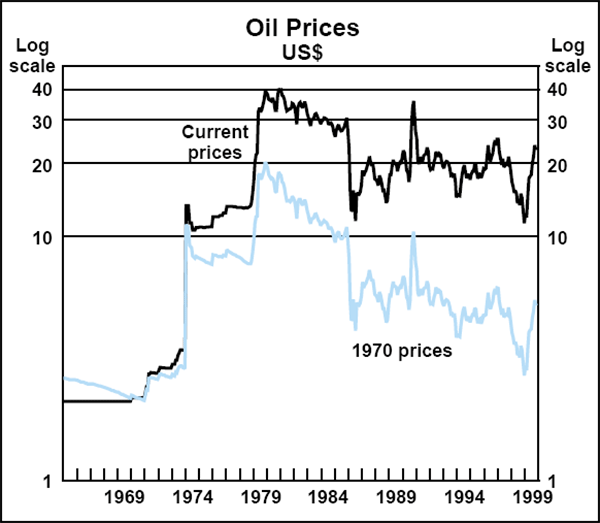
Both the cycle in world demand and variations in global oil production have contributed to the fluctuations in oil prices over the past three years. Since March 1998, oil-producing countries have been making efforts to restrict supply, but it was not until early in 1999, when world demand for oil began to pick up, that these efforts were successful. In March 1999, several oil-producing countries met and agreed to restrict the output of their state-owned oil companies, and in September they agreed to maintain these production restrictions. The effectiveness of these supply restrictions is evident in the sharp increase in oil prices that has occurred since March.
Changes in the price of crude oil affect domestic inflation directly, via their effect on the retail price of petrol, and indirectly, via increases in production costs more generally and increases in the prices of substitute goods.
The direct effect of increases in crude oil prices on inflation is easily identified. Increases in crude oil prices are first reflected in the refined petroleum price, and then in the retail price for petrol. Retail petrol prices have a weight of 4 per cent in the current Consumer Price Index (CPI). Pass-through of changes in crude oil prices to retail petrol prices occurs rapidly, with most changes being fully passed through within six months (Graph D2). The total percentage change in the retail petrol price, however, is always much smaller than the percentage change in the crude oil price. This is mainly because Federal and State excise taxes, which are levied per litre of petrol sold, account for a substantial proportion of the retail petrol price. (The excise rate is currently 43.5 cents per litre for unleaded petrol.) Other costs involved in wholesaling and retailing petrol, such as wages, storage and transportation costs, are also significant; movements in these costs are fairly stable over time. Overall, this implies that only 20 to 30 per cent of the retail price of petrol is directly dependent on the price of crude oil.
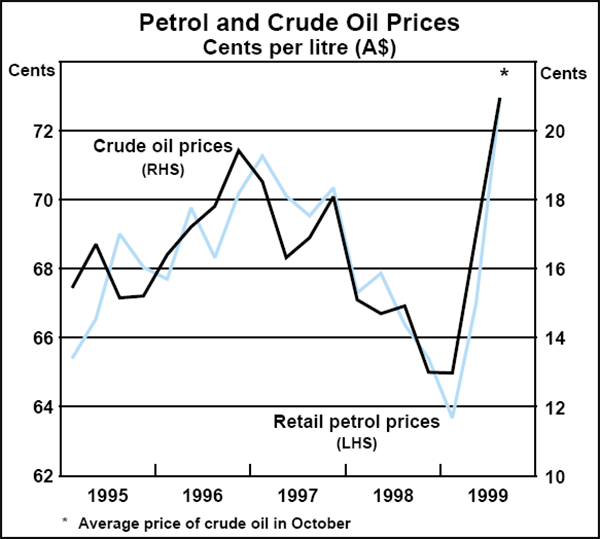
Between early 1997 and early 1999, crude oil prices fell by around A$13.50 per barrel. This contributed to an 11 per cent fall in retail petrol prices, and reduced the headline CPI by 0.5 per cent. Since early 1999, crude oil prices have risen by around A$16.00 per barrel and retail petrol prices have risen by around 17 per cent. Based on past relationships, and assuming crude oil prices remain around the October average level, this increase in crude oil prices would directly increase the CPI by a little over 0.6 per cent. Most of this has been captured in the June and September quarterly movements in the CPI.
The indirect effect of higher oil prices on inflation is more difficult to identify and quantify. At an aggregate level, it is difficult to discern the effect of movements in oil prices on the underlying price level, although some effect on the energy-intensive components of the CPI, such as transportation and travel, can be found. The prices of other sources of energy, such as coal and gas, also appear to be affected by oil price movements, though these relationships are quite loose, and depend on the state of world demand and stock levels. There is some evidence that higher oil prices have begun to contribute to higher production costs in some industries. The cost of materials used in manufacturing, for example, increased by 3.9 per cent between the March and September quarters 1999, largely reflecting the pick-up in oil prices. The latest NAB and ACCI-Westpac surveys also point to a modest increase in both actual and expected production costs. In the NAB survey, increases in production costs were strongest in the transport, storage and communications sector and the mining sector, both of which are relatively energy intensive.
Footnote Box C
The Government announced earlier this year the sale of a further 16.6 per cent of Telstra, bringing private ownership of the company to 49.9 per cent. The sale of this tranche of shares was known as Telstra 2, with total proceeds of $16.1 billion; investors were required to subscribe in two instalments, the first in September/October 1999, with the balance due in November 2000. [1]